- Get Paid to Review Campsites!

Stay in the Loop
Subscribe for exclusive content, giveaways, new products and more!

- Backpacking
- Backcountry Cooking
- Wilderness Medicine
- Destinations
- TRIP REPORTS
Canoe Camping Meals: 10 Easy Canoe Trip Recipes
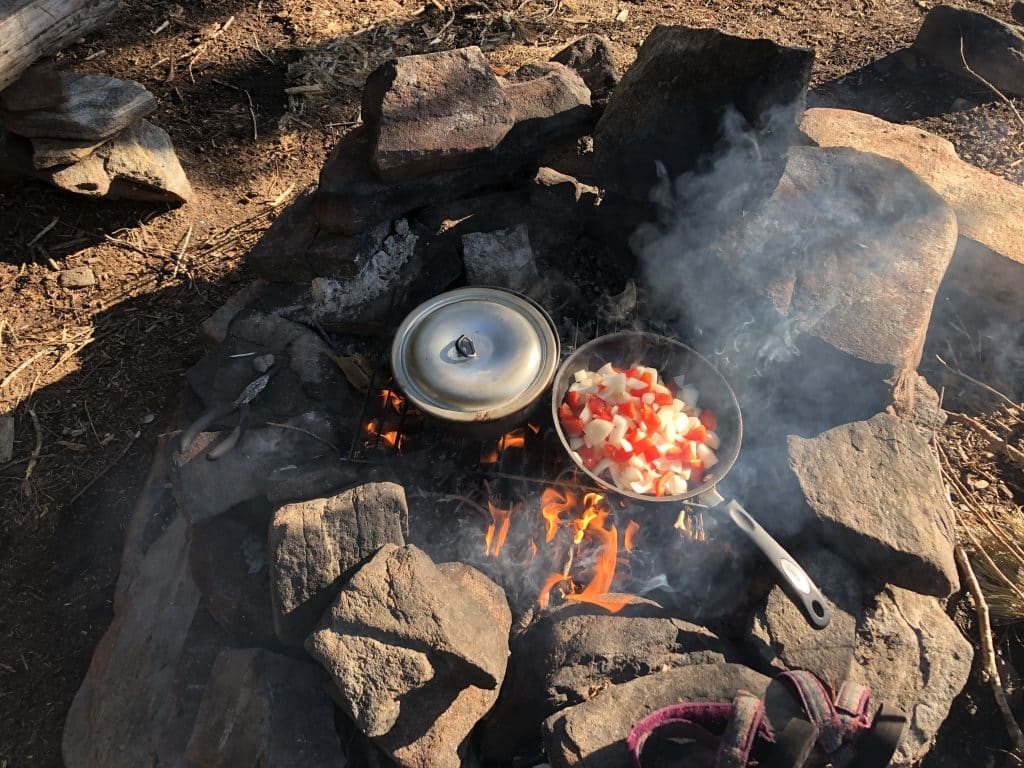
After a long day of paddling and portaging, there are few things better than starting a fire and cooking up a nice warm meal. Backcountry cooking is one of my favourite parts of a canoe trip, so I love any opportunity to experience backcountry-adapted gourmet canoe trip meals.
In this post, you’ll find 10 canoe camping recipes to try on your next trip.
For more canoe trip recipes (and a comprehensive guide on how to build the perfect canoe trip menu) check out my eCookbook: The Voyageur’s Backcountry Cookbook .
Canoe Trip Breakfast Ideas
1. breakfast sandwiches.
Another great choice is breakfast sandwiches. If it’s early in the trip, you can bring English muffins. If you want to have this meal later into the trip, you can use wraps, powdered egg and bacon bits or sausage.
Ingredients : wraps or English muffins, powdered eggs, powdered milk, bacon or sausage, ketchup packets, cheese optional: avocado, tomato
Instructions :
- Mix powdered eggs and powdered milk at a 6-to-1 ratio and mix with water until thick and runny. Scramble the eggs.
- If needed, cook the bacon and toast the english muffins.
- Add scrambled eggs, bacon and cheese to english muffin or wrap. Add toppings and ketchup and close.
- Optional: Wrap in tin fold and heat over the fire to keep them warm and toasty while you wait for your coffee to brew.
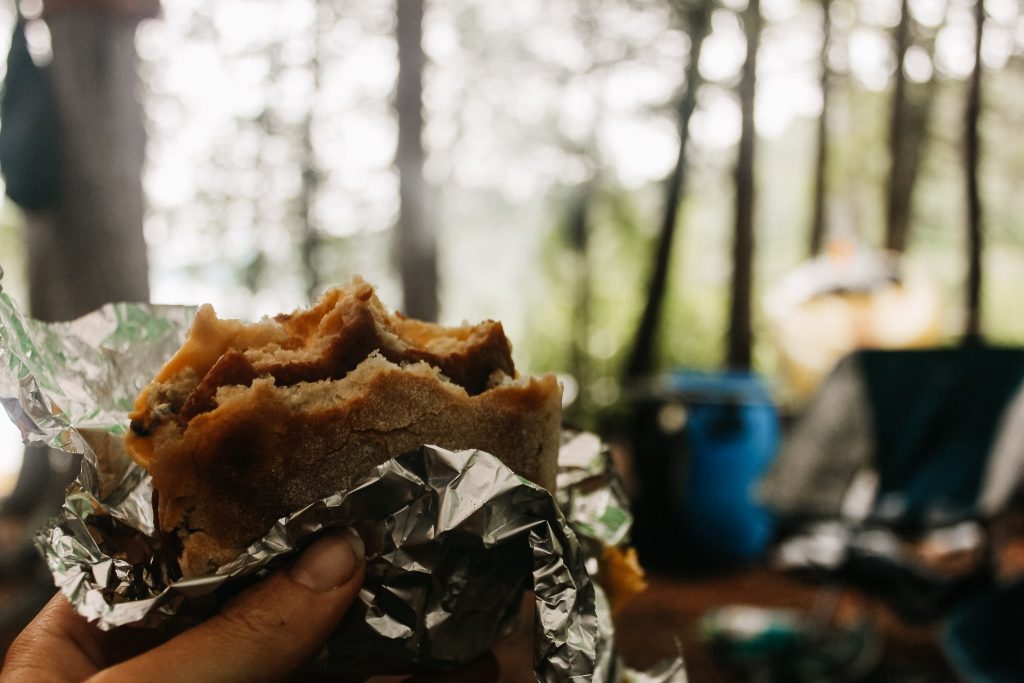
This post may contain affiliate links. If you make a purchase through one of these links, I may receive a small commission at no extra cost to you. Your support is much appreciated! You can learn more by reading my full disclosure .
2. Cinnamon Buns
Another classic for a rest day is cinnamon buns. They require a Dutch oven and some prep work, and you’ll want to make sure you pack some butter dedicated for this meal because it needs a lot of butter.
Ingredients : baking mix*, flour, brown sugar, cinnamon, butter, optional: nuts, raisins, powdered sugar
- Add equal parts flour and baking mix into a bowl with a little cinnamon; gradually add water and stir. You want a ball of dough that holds, but you don’t want it too sticky.
- On a cutting board with a little flour, roll out the dough so it’s flat and in an oval.
- Spread butter over the surface of the dough, then add a generous amount of brown sugar. Sprinkle cinnamon and nuts / raisins.
- Roll it lengthwise so it looks like a tube. Then, slice the tube so you have a bunch of little cylinders.
- Butter the inside of the Dutch oven. Be generous! Then put your cinnamon rolls (cylinders) into the Dutch oven. Place on the embers of the fire and wait. They will probably need ~20 minutes, but check regularly.
- Once crispy brown, remove and sprinkle some powdered sugar on top.
Tip : To make baking mix, combine 4 cups of flour, 2.5 tbsp of baking powder, 1/4 cup milk powder and 2 tsp of salt in a bag.
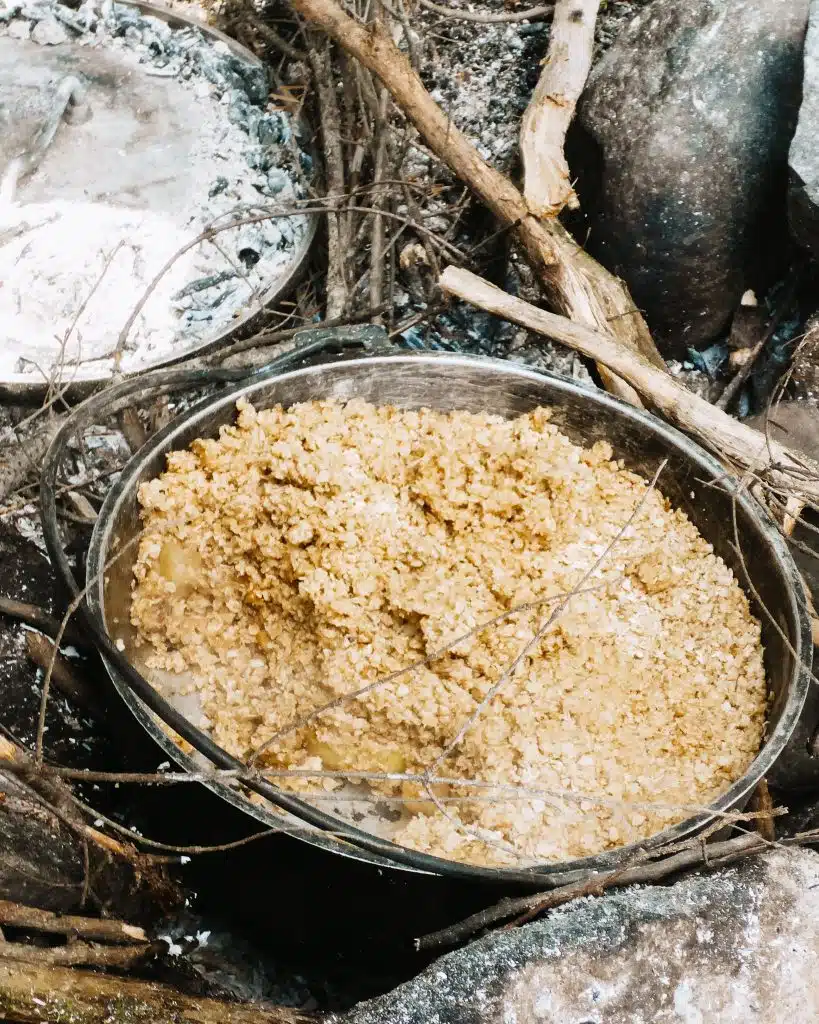
Bonus: Oatmeal
Oatmeal is my go-to backcountry camping meal because it’s so easy to make and clean up. Plus, there are a ton of ways to make oatmeal more interesting.
Here are two of my favourite recipes for oatmeal, and I have six other recipes in this blog post.
Sweet & Savoury Oatmeal
This recipe is met with mixed reviews. Cut leftover bacon into small pieces (or you could try packaged bacon bits) and top the oatmeal with shredded cheddar cheese and diced apples . A little nutmeg and brown sugar bring this bowl to life. As I said, this sweet & savoury bowl gets varied feedback – bacon in oatmeal?!? But hey, don’t knock it til you try it. I’m a huge fan now, myself.
Maple Oatmeal
Maple syrup in oatmeal – a Canadian classic, eh? Instead of brown sugar, sweeten this bowl with maple syrup , adding toppings like craisins and coconut to create texture. If you’ve got a fresh banana , a few slices go great with the maple.
Read More : 8 Recipes to Make ~Not Boring~ Oatmeal on Camping Trips
Tip : Don’t make the oatmeal in the pot! Instead, boil water in the pot and put quick oats in everyone’s bowl. Let each person add the amount of hot water they need to get their oatmeal to the desired consistency. I personally, like my oatmeal very dry and hate it when someone makes a single batch. This also makes cleaning up easier because you don’t have to wash a pot.
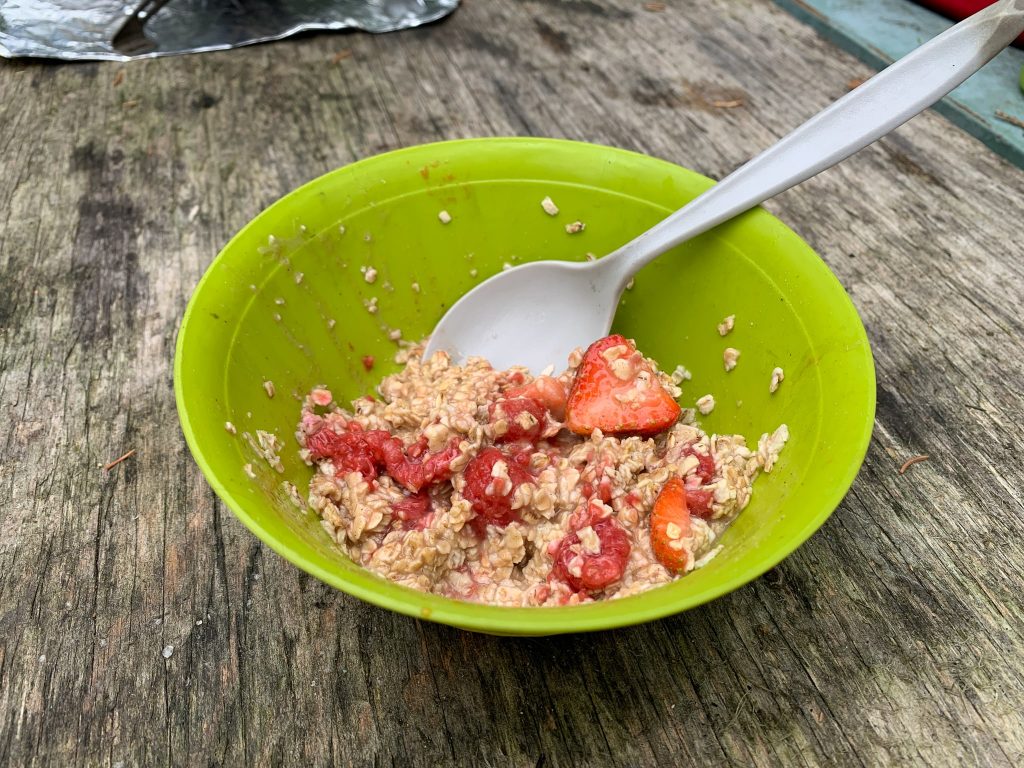
Canoe Trip Lunch Ideas
I typically eat a lot of wraps for lunch on canoe trips. They’re easy to pack, quick to make and there’s a decent amount of variety you can get with fillings.
3. Burrito Wraps
Burritos are a crowd-pleaser. They require some work the night before but are worth the effort. You can also cook rice and add it to the burrito to make it even more filling. This is also a great opportunity to use sriracha or other hot sauce.
Ingredients : wraps, cheese, onion, peppers, tomato sauce, refried beans
- The night before: If needed, rehydrate refried beans, tomato sauce and veggies by adding them to a saucepan or pot with a small amount of clean water. Stir regularly, adding more water as it is absorbed.
- Once everything is rehydrated, let it cool and then store it in a Nalgene or bag.
- Day of: Spread bean mixture in the centre of the wrap and add cheese. (Don’t use cheese if vegan).
- Fold into a burrito. You can heat the burrito over a stove if you’d like.
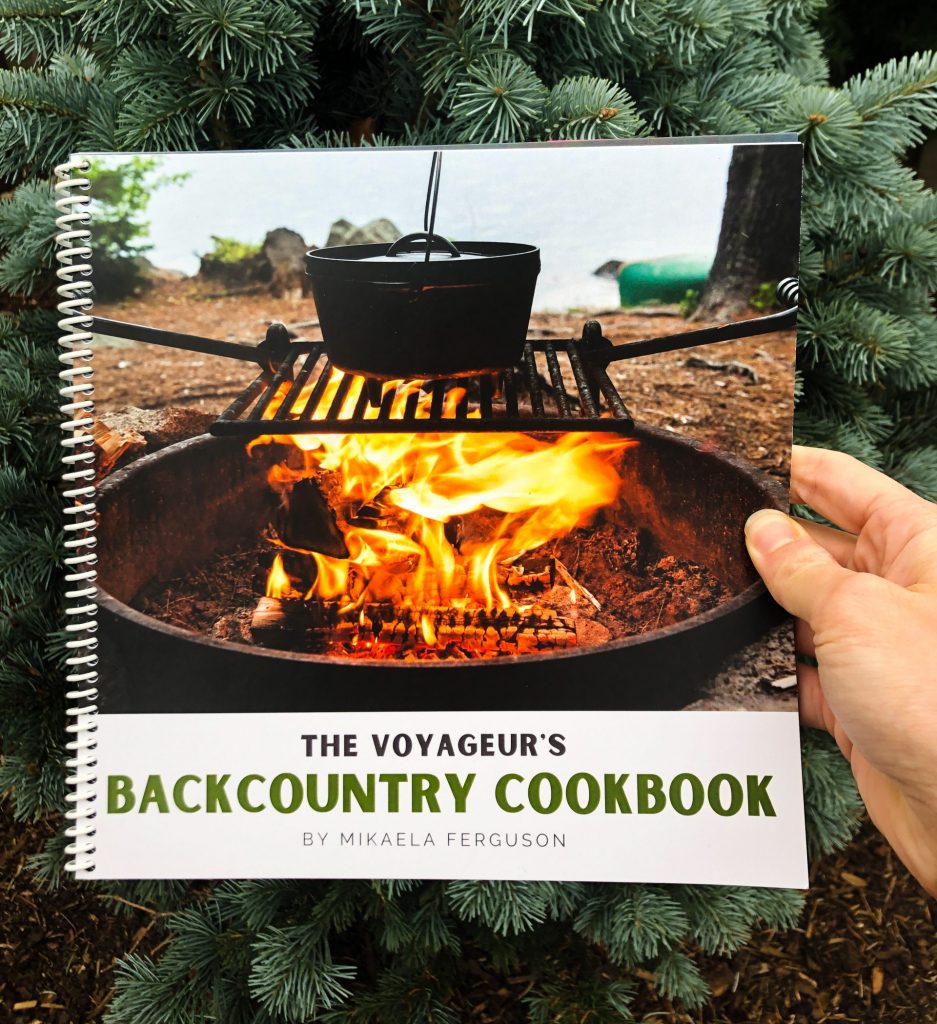
4. Hummus Buddha Bowls
This is a high-protein, high-nutrient lunch that you can make reasonably quickly. The only downside is that it does require a dish and utensil. But other than that, this is an easy canoe trip lunch idea!
Ingredients : Cooked quinoa, dehydrated hummus (you can purchase dried hummus or dehydrate your own ), nuts / seeds (I like pine nuts or crushed walnuts), spices, Flax Crackers and / or Vegetable Chips (see below for making your own).
DIY Veggie Chips : Thinly slice easily chip-able vegetables (i.e. sweet potatoes, zucchini, beet, carrot). Toss vegetables in a tiny bit of olive oil and salt. Place on parchment paper-lined baking sheet. Cook on low heat (max 200 F) for at least 45 minutes.
- Pack the dehydrated hummus with the spices and nuts / seeds.
- Cook the quinoa the night before and store it in a plastic bag or sealed container.
- Rehydrate hummus in a bowl by slowly adding water and stirring. You’ll probably need about 1/4 cup of water, but you’ll know you’ve added enough when it’s reached your desired consistency. You can also add a small splash of olive oil, which will give the hummus a nicer texture, but I’m usually too lazy for that.
- Mix the quinoa with the hummus and nuts / seeds.
- Scoop the hummus mixture with your crackers and veggie chips and enjoy!
Note : Most people prefer this without the cup of quinoa, but I just don’t find this meal filling enough without the added grain.
Bonus : Sprinkle some dried kale on top for extra nutrients and additional crunch!
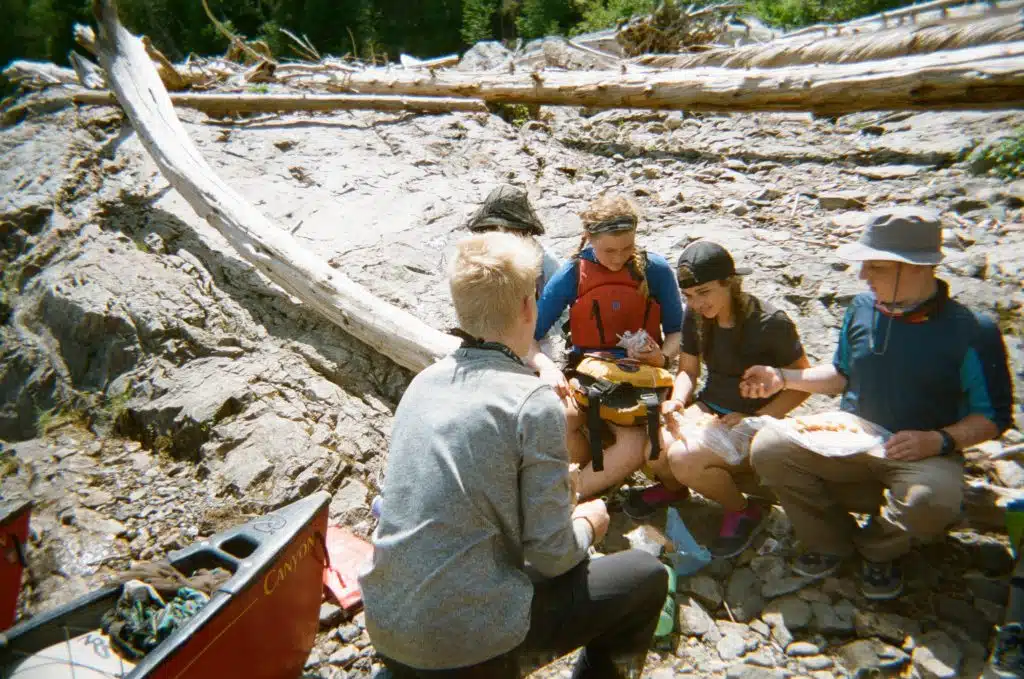
Canoe Trip Dinner Ideas
5. chilli & garlic bread.
This is my favourite camp meal. This is a meal best prepared by two or more people (someone to do the garlic bread and another to do the chilli).
Ingredients :
dehydrated ground beef or textured vegetable protein (TVP), dehydrated beans, dehydrated veggies, dehydrated tomato sauce, spices and bread mixture
- Make the garlic bread according to the instructions on page 42. Make chilli according to the instructions below:
- Add a splash of clean water to the pot and some dehydrated tomato sauce. Stir regularly. As the sauce absorbs water, add a little more.
- Once the sauce is almost rehydrated, add in the vegetables, and ground beef or TVP and big handfuls of dehydrated beans. Continue stirring and adding water if necessary. Add spices.
- Stir regularly. If the chilli looks too thick, add water. If the chilli looks too watery, add either more TVP or put a small handful of potato pearls.
- Let simmer on low heat.
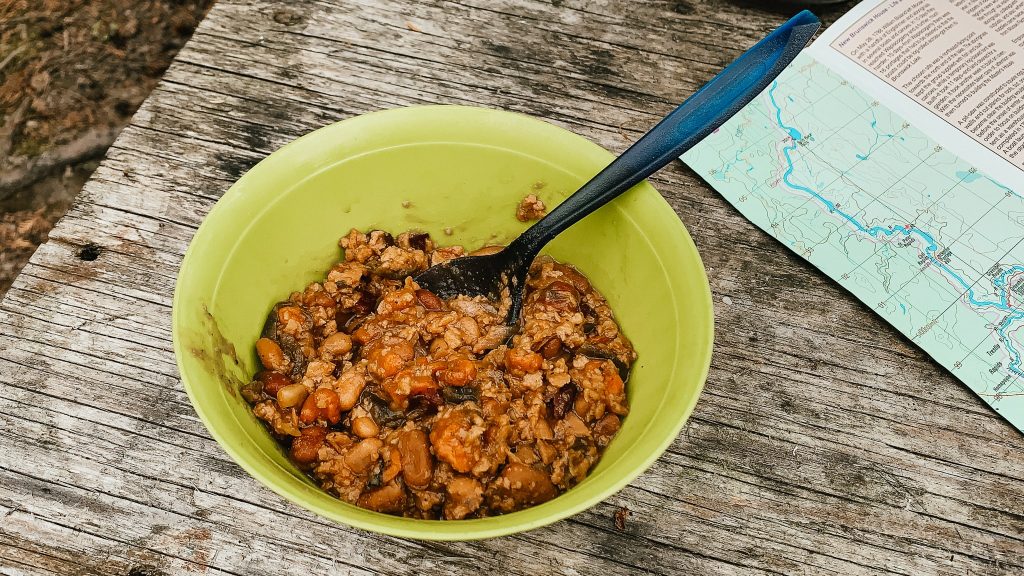
6. Thai Red Curry
This is a super easy but super delicious meal to make. It’s so easy because most of the flavour comes from the red curry paste. You don’t need to refrigerate the paste before you open it, so I’ll buy a few small jars.
Ingredients : rice, coconut milk, jar of red curry paste, cayenne pepper, onion, peppers, mushrooms, zucchini, chickpeas.
- Boil water in a pot. Pour in rice and stir. Go with a water-to-rice ratio of 2:1.
- In a frying pan, rehydrate veggies and chickpeas if necessary. Pour in a can of coconut milk. Add some red curry paste and a pinch of cayenne pepper.
- Once rice is cooked and the sauce is done, scoop rice into bowls and add a big spoonful of sauce onto the rice.
- You can garnish with cilantro and peanuts if you’d like.
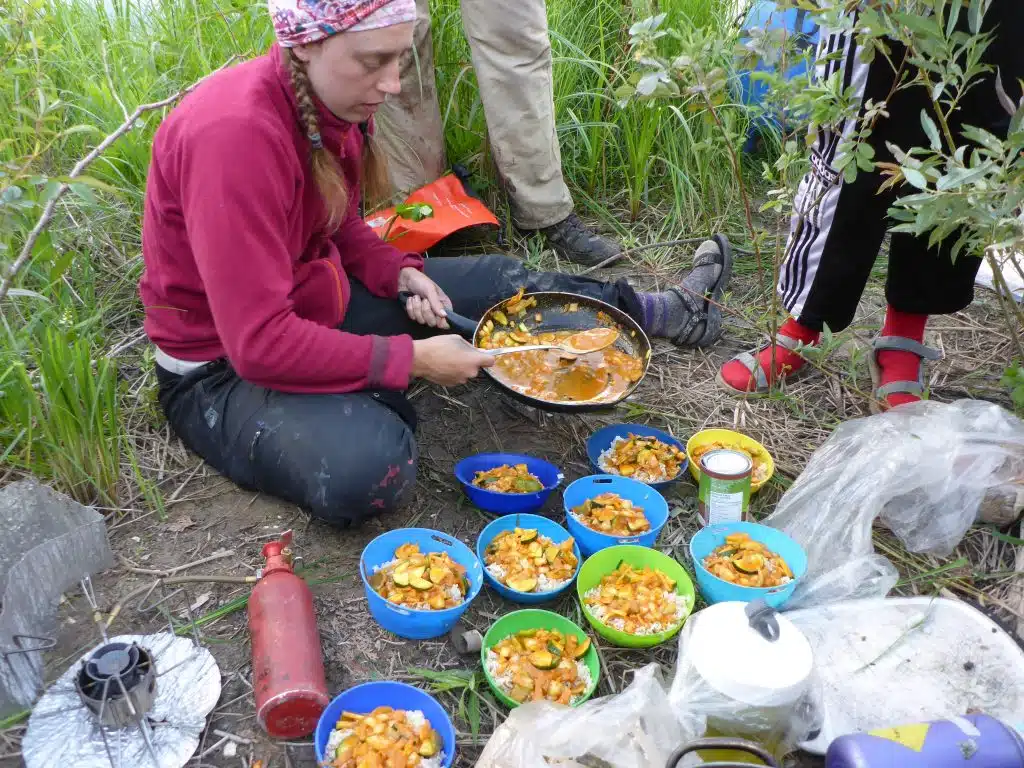
Canoe Trips Snacks
7. protein-based snacks.
So much of the food on canoe trips – especially the snacks – is carb-based. This is great for quick energy, but sometimes you need something with more fat and protein to sustain you on those long days.
Dates + Cheese + Pepperoni
This may seem like a weird combo, but it works out to be the perfect salty-sweet snack. Stack a date on a small slice of cheese and wrap in pepperoni. It’s actually very tasty.
This is a tasty, yet filling snack option. You can buy beef jerky in bulk or make your own and eat it after a long portage. The salt will be good after a long period of sweating!
Pepperoni Sticks
Similar to the above, pepperoni sticks are a filling afternoon snack. And if you want to experiment, use those individual packets of cream cheese as a dip. Personally, I love it.
Tuna on Crackers
Another high protein option, you can bring tuna canned or in individual packets (you can even get different flavours). Scoop onto crackers and enjoy!
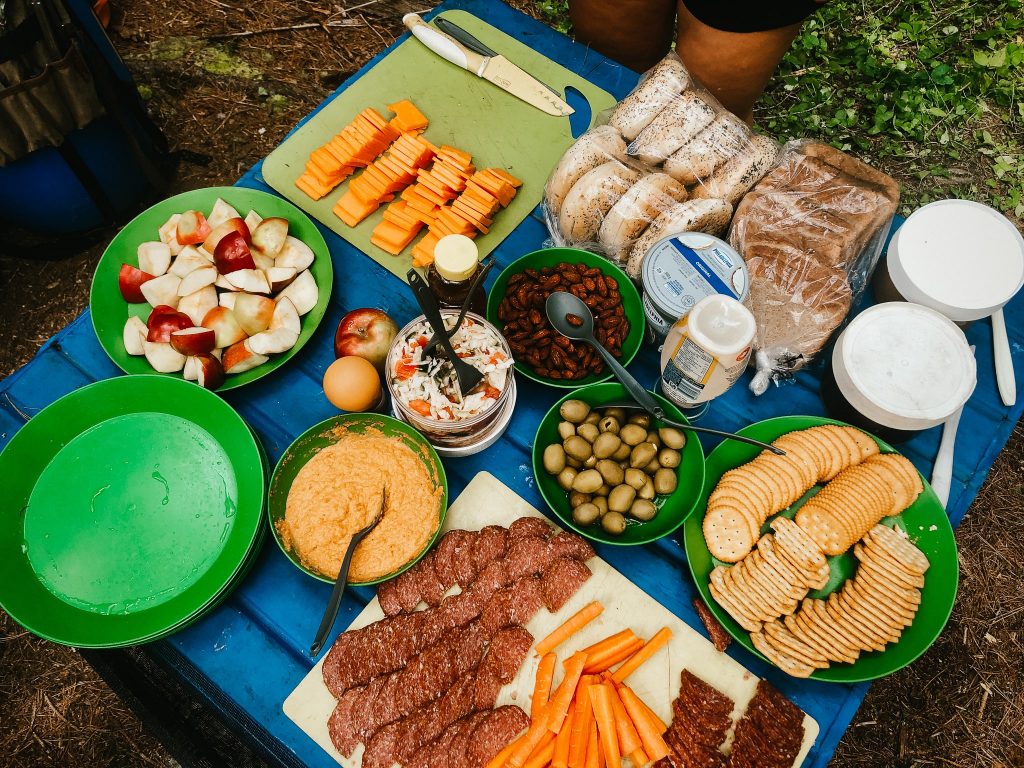
8. Homemade Fruit Leather
Rather than buying (expensive) store-bought fruit leather, you can easily make your own at home in either a dehydrator or in your oven. Below I’ve outlined the steps that I take to create fruit leather at home.
If you don’t want to make your own, this is my favourite store-bought fruit leather. My only issue with it is that I need two to feel satisfied and they’re pricey – definitely buy in bulk rather than from the grocery store!
Note that I do all my dehydrating in an oven, rather than a dehydrator. If you have a proper dehydrator at home you can still follow this process but you may need to adapt a few steps for your specific dehydrator.
Ingredients : Apple sauce, optional: cinnamon, nutmeg, shredded coconut, chopped nuts.
- Preheat your oven to the lowest temperature setting it has.
- Line a baking sheet with parchment paper. Do not use wax paper!
- In a big bowl, pour in a can of apple sauce.
- This is the creative part: mix in any additional toppings / fillings that when make your fruit leather more fun. I always add cinnamon and nutmeg; I’ve also experimented with shredded coconut. I think chopped nuts could also be really tasty, though I’ve never tried that myself.
- Use a spatula to pour your mixture onto the parchment paper and spread until it’s a consistent thickness across the sheet, no more than 1/2 inch thick.
- Place in the oven.
- Cook time will depend on the thickness of your spread apple sauce and your oven’s lowest temperature, but I’ve found it to take about 6-7 hours in my oven.
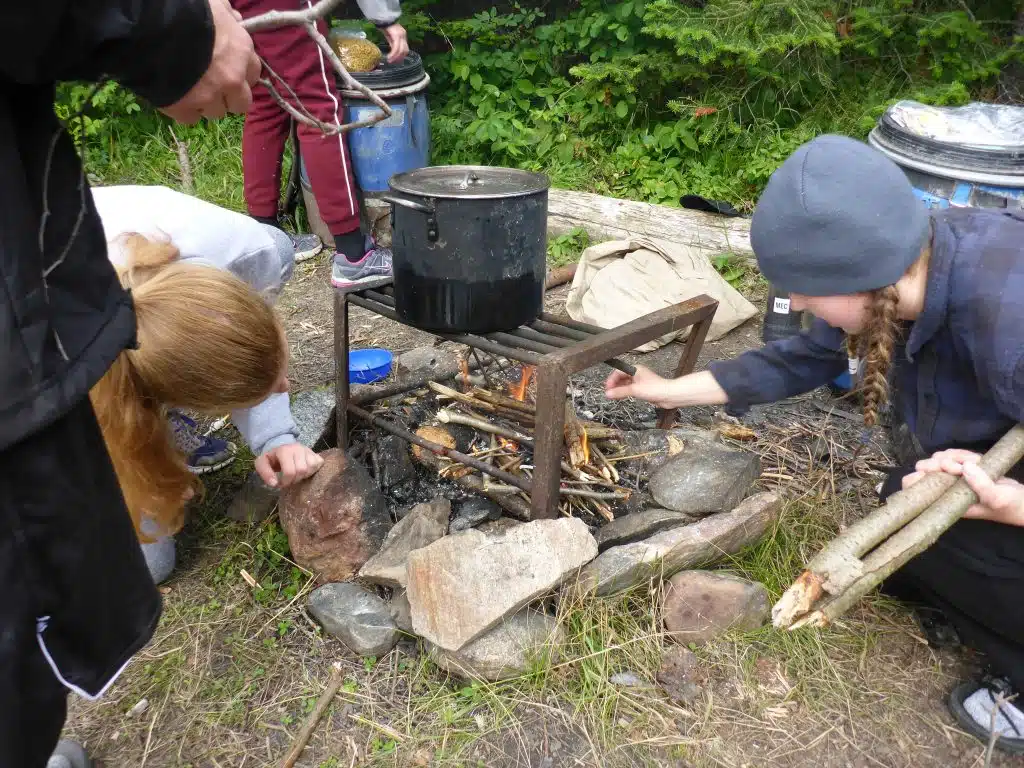
Canoe Trip Desserts
9. lazy cheesecake.
This is such a lazy dessert I’m almost embarrassed to include it, but it’s so tasty. And it’s an awesome dessert if you are camping somewhere that has wild blueberries!
Ingredients : cheesecake powder, graham crackers, chocolate chips or fresh or dried blueberries
- In your bowl, add a few spoonfuls of cheesecake powder. Add clean water slowly, stirring until it is a thick liquid.
- Crush graham crackers over your bowl and add either chocolate chips or fresh blueberries. Enjoy!
Note : You could also make this un-lazy, by making a graham cracker crust and cooking it in a Dutch oven (page 63 of my cookbook).
10. Chocolate Cake
This is what I try to prepare whenever there is a birthday on trip. I discovered it on MyCCR a while back and fell in love. I use a Dutch oven, but if you have Reflector Oven and cake pan you can use that instead.
Ingredients : chocolate cake mix, instant chocolate pudding, milk powder, egg powder, water, butter, flour, chocolate chips, icing sugar.
- Mix 1/2 box of cake mix with 1/2 package of instant pudding mix, 1/2 cup of milk powder and 1/4 cup egg powder (you can put this all in a plastic bag at home).
- Grease a Dutch oven with butter. Sprinkle a little flour on the butter (this helps with sticking).
- Pour the dry ingredients and 1 cup of water in the Dutch oven and stir. If the mixture is really thick, add a little more water.
- Cover Dutch oven and place in the embers of the fire.
- After 30 minutes, check on the cake. Stick a fork in the middle – fork should come out dry if the cake is done.
- When done, use a knife to separate the cake from the oven along the edges. The cake may come out with the knife, or try flipping the oven upside down and over a plate or cutting board, and giving it a little shake. The cake should fall out (flip the cake over so it’s right side up).
- Finally, sprinkle some icing sugar on top, cut and serve! You can also bring shelf-stable icing to spread on top.
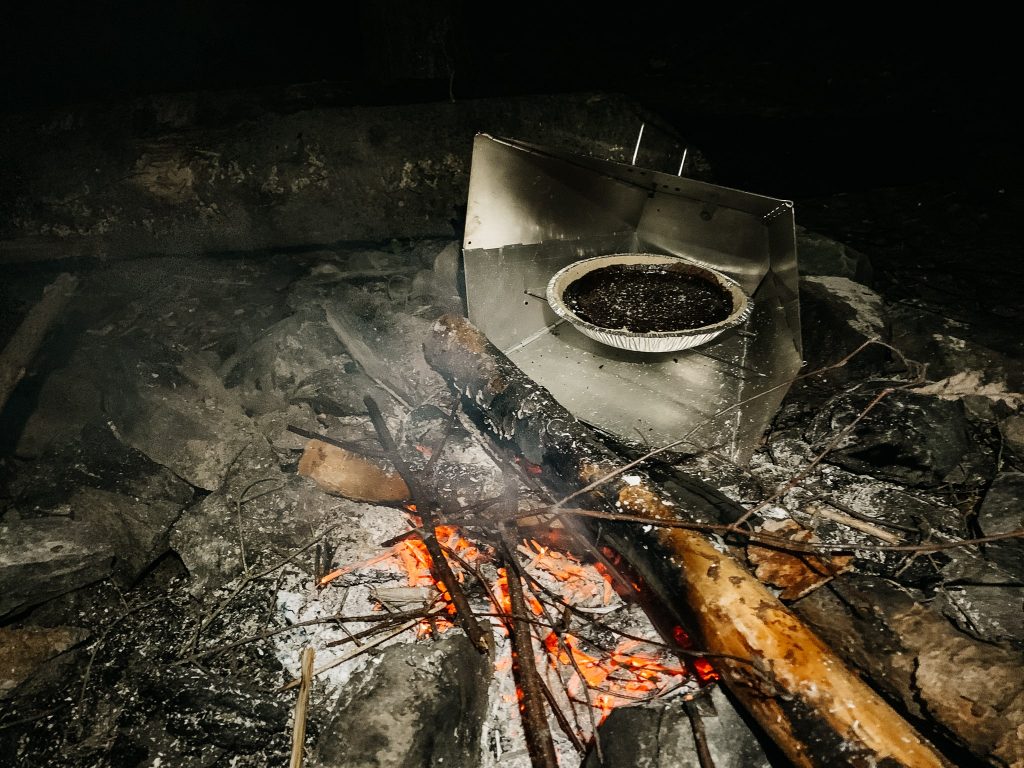
Canoe Trip Recipes – Final Thoughts
If you need more inspiration for creating excellent canoe trip meals, consider checking out The Voyageur’s Backcountry Cookbook . It has a ton of canoe trip food ideas, plus tips for meal planning, food preparation, dehydration and more.

Mikaela | Voyageur Tripper
Mikaela has been canoeing, hiking and camping for over ten years. She previously worked as a canoeing guide in Canada, and spent a season guiding hiking and kayaking tours in the high Arctic. Mikaela is a Wilderness First Responder and Whitewater Rescue Technician.
MY FAVOURITE GEAR
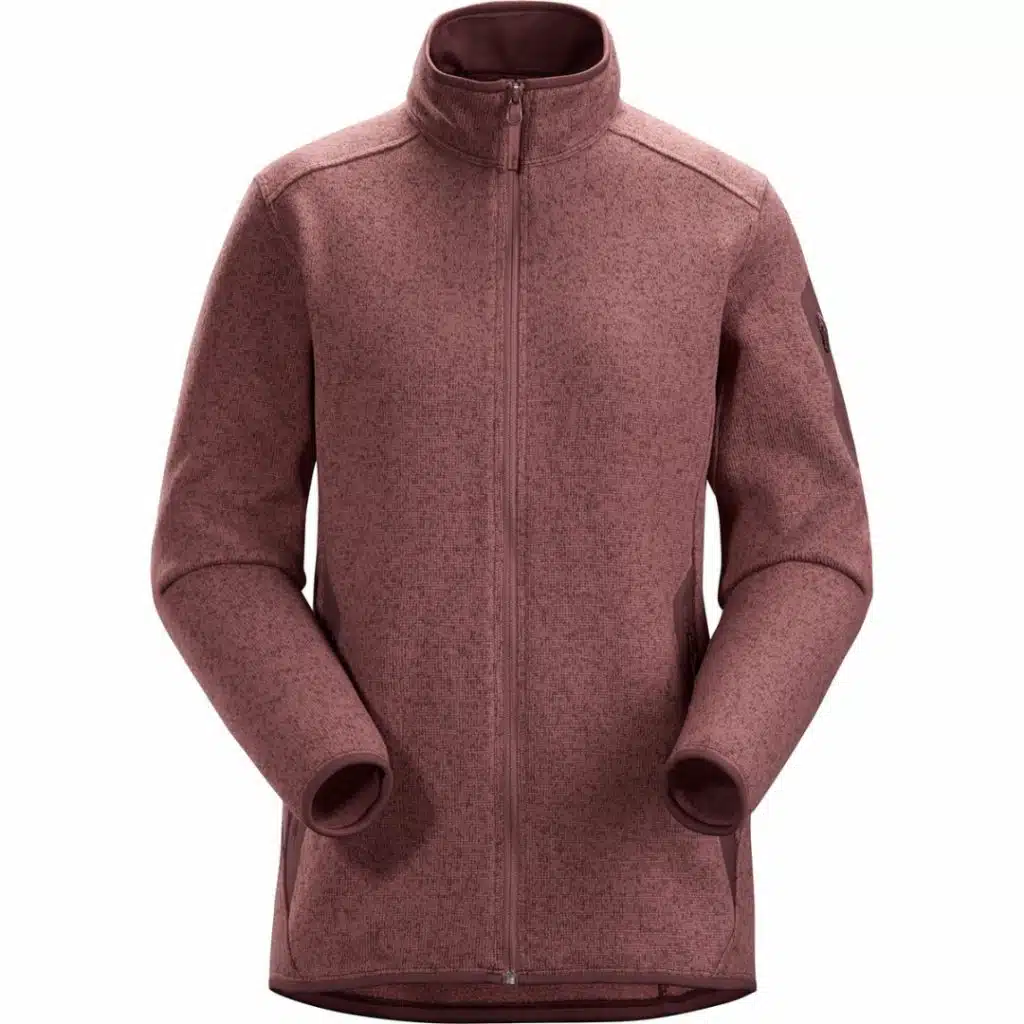
Fleece Sweater
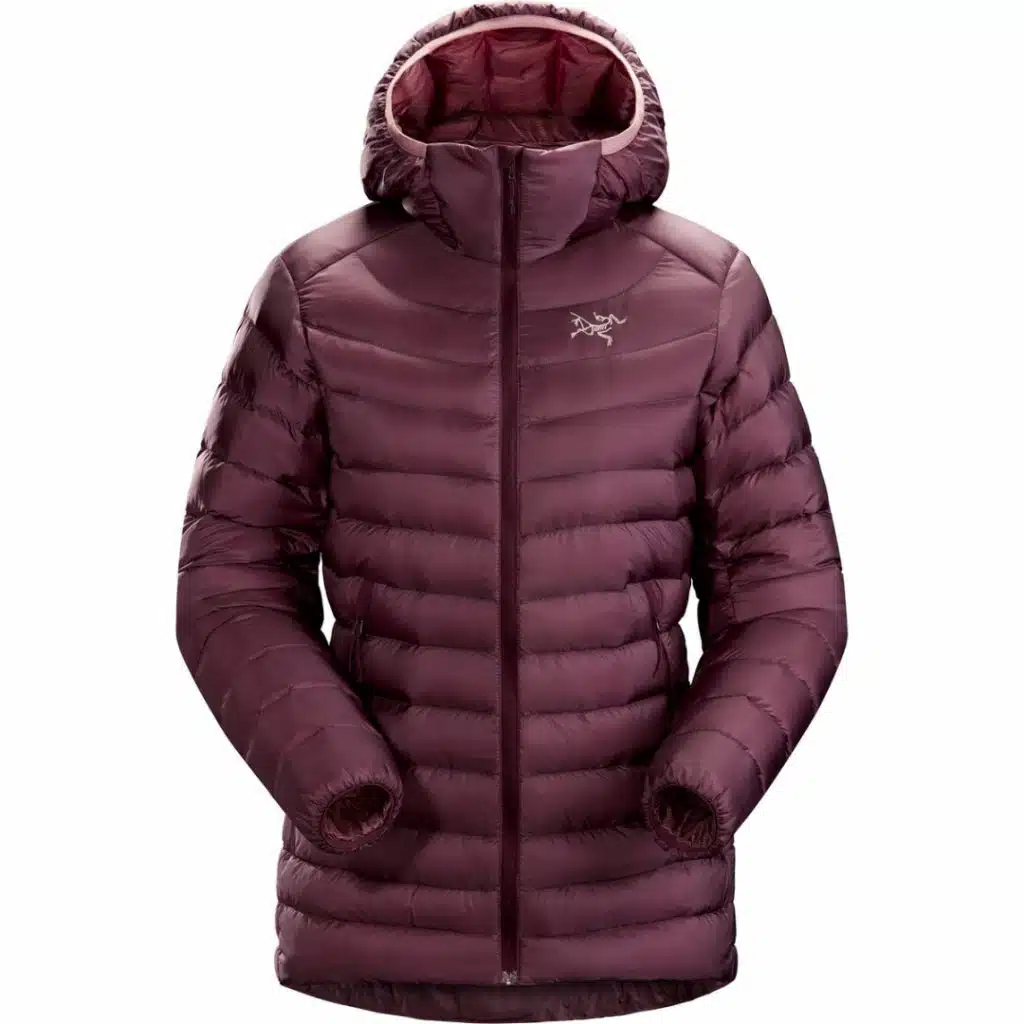
Down Jacket
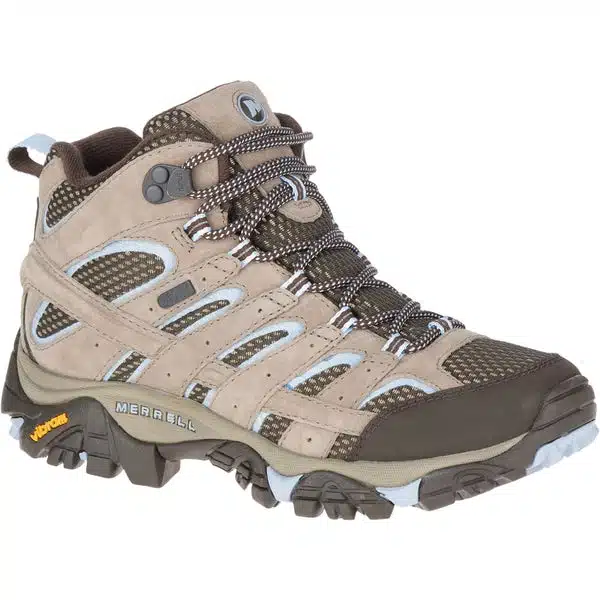
Hiking Boots
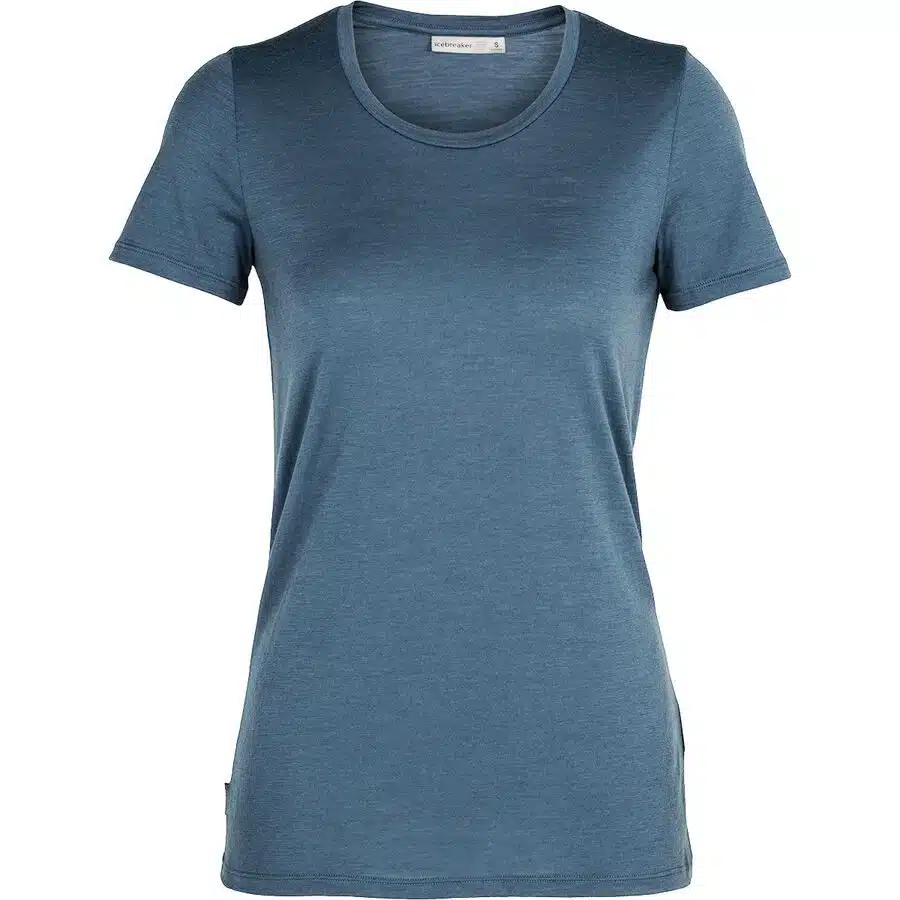
Hiking Shirt
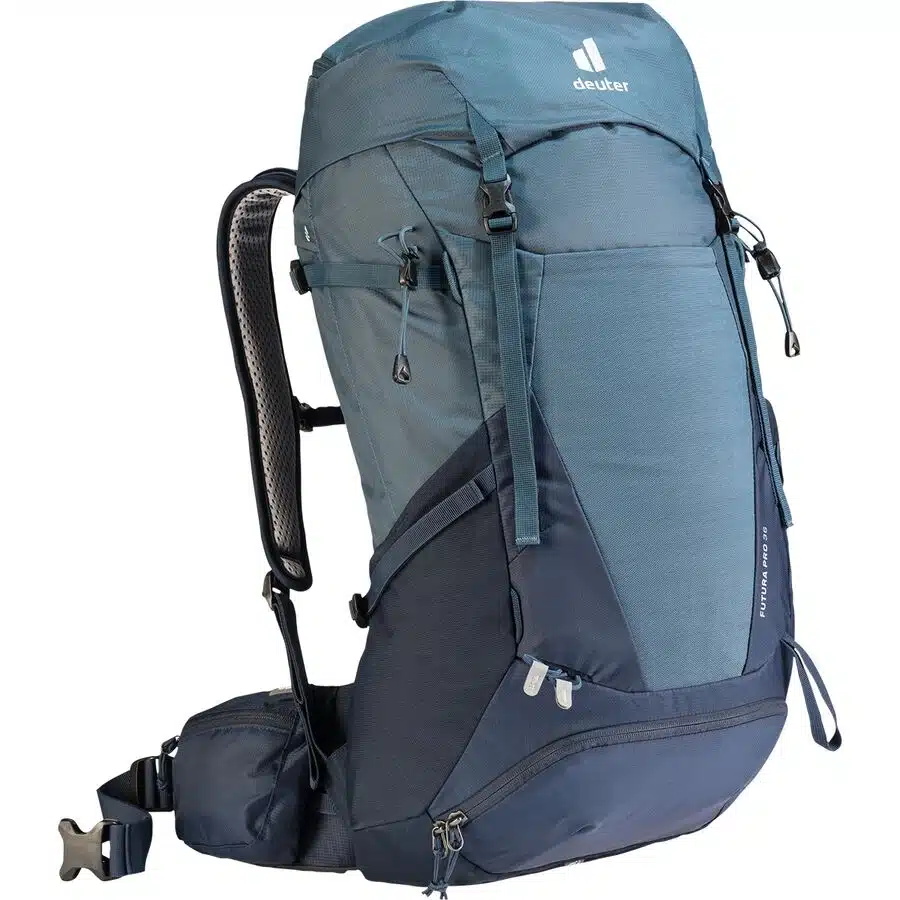
Hiking Pants
1 thoughts on “ Canoe Camping Meals: 10 Easy Canoe Trip Recipes ”
Stay in touch.
Join our community of outdoor adventurers - you'll find trip inspiration, gear discussions, route recommendations, new friends and more!
Where do you source your cheesecake powder. I am only able to see very large quantities for over $100. I can see a Jello no Bake cheesecake mix, but it doesn’t seem the same as the cheesecake powder.
Leave a Reply Cancel reply
Your email address will not be published. Required fields are marked *
Save my name, email, and website in this browser for the next time I comment.
- Facebook Group

How to Plan Food for a Canoe Camping Trip
By sarah coupal & aaron owens mayhew, ms, rdn, cd, updated january 4, 2024.
This post may contain affiliate links.
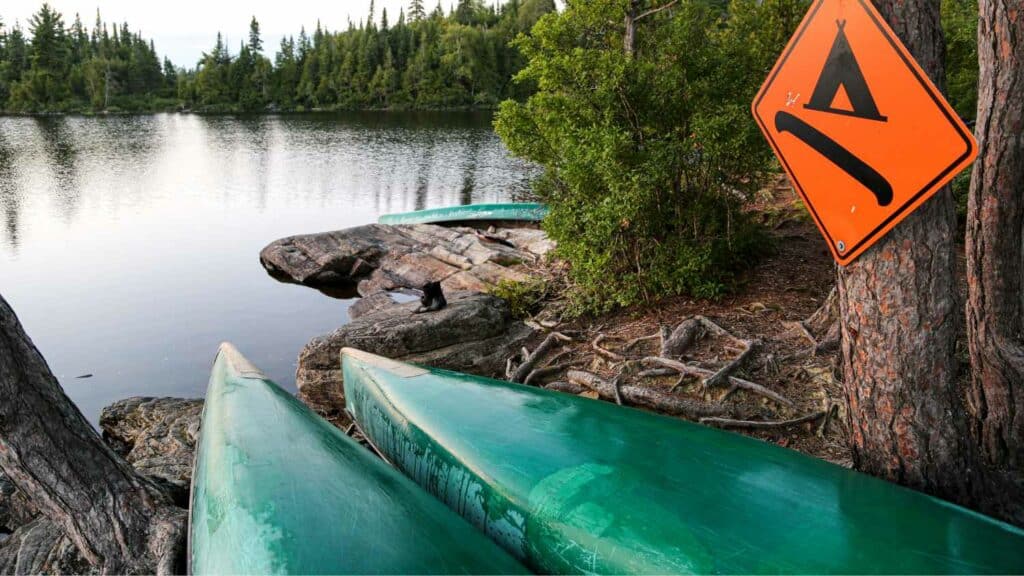
Factors to Consider | Amount of Food to Pack | Which Foods to Bring | Canoe Trip Hydration
Curious about packing food for canoe camping trips? Are you looking to transition from day paddles to overnight trips? Whether you are an experienced paddler looking to improve your nutrition or just curious about what canoe camping is all about, this article is for you!
Here at Backcountry Foodie, our main focus is food to fuel your hiking and backpacking trips. That said, the food for a paddling trip (canoe, kayak, or SUP) is not too different. The fact that you don’t have to carry everything on your back might even give you more flexibility in your meal planning. If you’re a foodie and have never been canoe camping, this post might convince you to try it!
What is Canoe Camping?
Canoe camping trips are multi-day trips where you paddle between campsites on lakes and rivers. All of the gear you need is carried in your boat. When lakes and rivers do not connect, you must portage (carry) your boat and all your gear on trails or roads.
What Should I Consider When Planning Food for a Canoe Camping Trip?
First, think about the length of your trip. This will determine how much food you need to pack and the types of food you can bring. For shorter trips, you may be able to bring some fresh food. For long trips, space, weight, and the shelf life and durability of your food will be more of a concern.
You should know the mileage of your route and your average paddling speed . From this, you can calculate the hours per day you will be paddling and portaging (if applicable). This is important because you burn significantly more calories when exercising than when sitting at camp or floating down the river.
Think about the weather as well. Being on open water means you will be more exposed to wind, which could make it harder to paddle. Shivering can burn up to 400 extra calories per hour if you get wet from rain or capsizing.
Finally, how will you store your food? Some people have canoe barrels or wanigans , which are food storage methods designed specifically for canoe tripping. You can also use a backpacking bear can or do a classic bear hang. As always, check the food storage regulations for the area you will be camping in.

How Much Food Should I Pack for a Canoe Camping Trip ?
Well, it depends.
Many factors affect how much food you must pack for a canoe trip. Like backpacking, the best way to dial in on the fuel your body needs is to keep a food journal with the following details:
- Conditions of the trip
- What you ate
- How you felt
- Any other details you think are relevant
You can then use this information to plan for future trips, ensuring that what you pack is personalized to your needs.
Here are some general guidelines to think about when deciding how much food to pack:
- You could burn anywhere from 200-700 calories per hour for every hour of paddling. This wide range depends on your weight, fitness level, speed, and water conditions.
- Long portages will have a larger impact on your calorie needs compared to easy paddling for the same amount of time.
- For low-intensity paddles, aim to eat 30-60 grams of carbs per hour. For more intense exercise, you should be eating 60-90 grams of carbs per hour. See our Best Backpacking Foods for Energy post for more information about carbohydrate serving sizes and snacks.
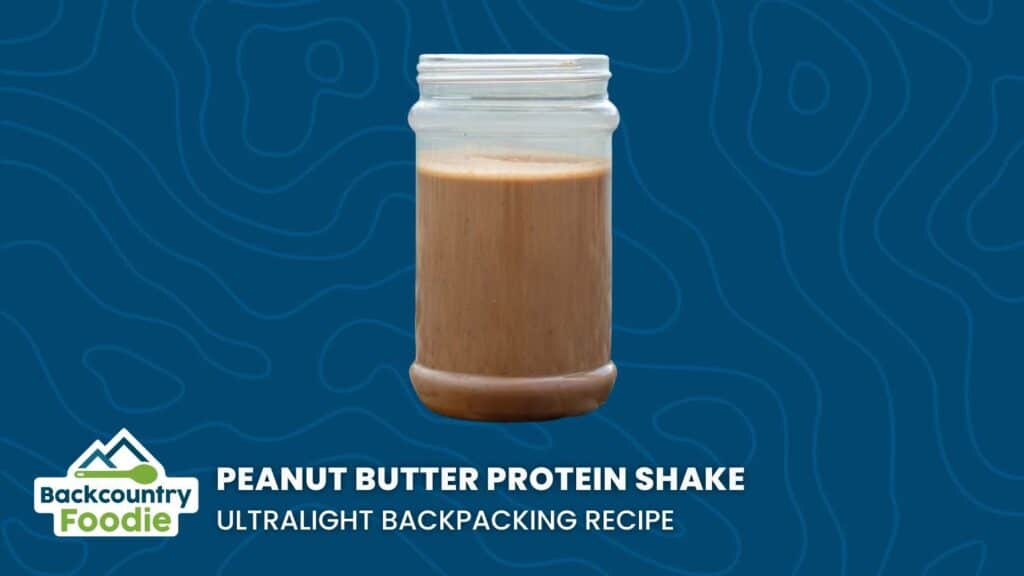
Are you also a day hiker or backpacker?
Here’s a great resource for determining calorie goals.
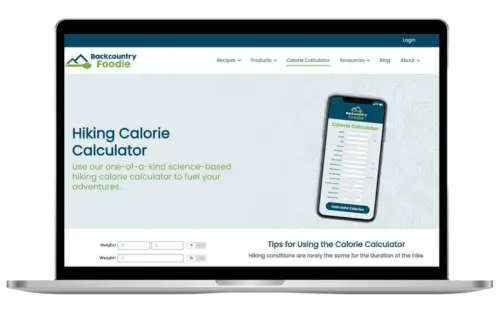
We created a one-of-a-kind hiking calorie calculator that takes all of the guesswork out of deciding how much food to pack for your adventures.
It’s a FREE resource, too!
Click on the link in the header bar or the button below.
What Food Should I Bring on a Canoe Camping Trip?
Choosing which foods to bring on your trip depends on personal preference and the details of your trip.
Short, Laid-back Trips
For short trips with few or no portages, many people opt to bring fresh foods similar to what they would eat at home. However, if you are planning to get into some serious backcountry cooking on your trip, we would not recommend bringing fresh meat, fish, eggs, or dairy products (with the exception of hard cheeses). These foods should not be kept unrefrigerated for more than 2 hours. Dry milk , powdered eggs , tuna or chicken packets, and jerky are good alternatives. Some foods also do not pack well (e.g., bananas), and the size of your food storage container (canoe barrel, bear bag) will determine how much you can pack.
Some fresh foods that keep well include:
- Potatoes, carrots, peppers, onions, cabbage
- Apples & oranges
- Sharp cheddar cheese
Leave No Trace
If you plan to bring fresh foods on your trip, make sure to pack out all food scraps to dispose of when you get home. It can take an orange peel up to 6 months to decompose! Also, make sure to wash your dishes away from water sources, even though it can be tempting to give them a rinse directly in the lake or river.
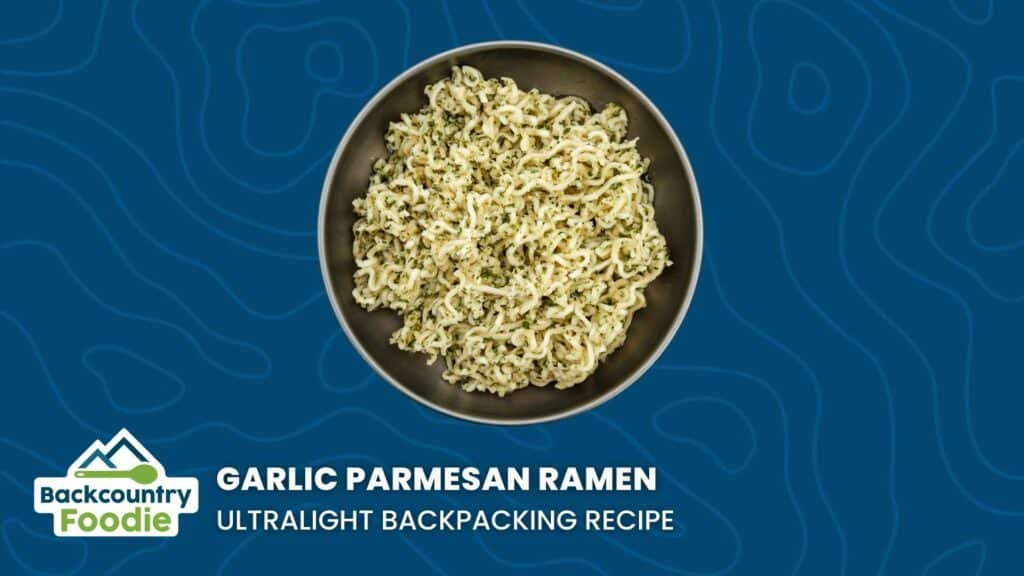
Longer, More Strenuous Trips
For multi-day trips and trips with long portages, we would recommend mostly dried foods. You’ll probably be trying to pack a lot of food in addition to all of your other gear. Backcountry Foodie has tons of great recipes that are low-volume, lightweight, and loaded with nutrition. These foods will last for even the longest trips.

Regardless of the length of your trip, make sure to pack plenty of snacks. Plan to eat every 30-90 minutes when you are actively exercising, depending on the intensity of your activity.
Don’t have time to prep DIY meals?
Not to worry! We offer a variety of Backcountry Foodie meals and meal replacement drink options in our shop . Here are just a few…
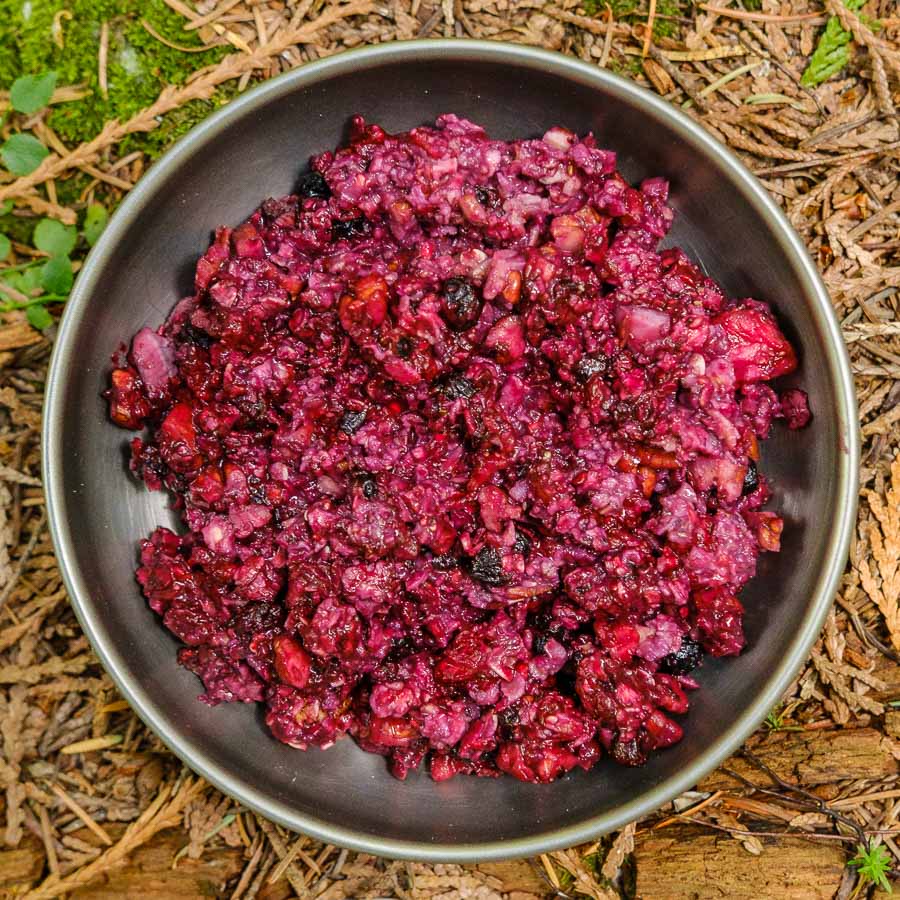
Sign-Up & Save!
Subscribe to our weekly newsletter & save 10% off Backcountry Foodie memberships.
Your email is safe with us. We don’t like spam either.
Hydration while Paddling
Hydration is an important part of fueling for paddling. You are often very exposed to wind and sun and might not notice how much you are sweating if your sweat evaporates quickly.
The amount of water you should drink per hour varies depending on how heavy of a sweater you are. For light sweaters, 0.5-1 liter of water per hour is a good estimate, whereas heavy sweaters can lose up to 2 liters of water per hour.
You also need to eat foods with salt to stay hydrated. You can lose 100-4000 mg of sodium (salt) per hour, depending on how much you are sweating and how salty your sweat is.
Some salty snacks to consider packing include:
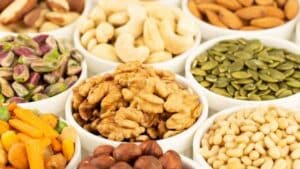
- Trail mix/salted nuts
- Dried hummus
- Triscuits or other crackers
As you might have noticed, canoe-tripping food is not too different from backpacking food. The best foods to pack vary depending on your trip and personal preferences.
Putting It Together
Keep in mind these factors the next time you are planning a canoe trip:.
- Length of your trip
- Miles you will travel each day
- Speed you plan to travel
- Food storage
- Personal needs and preferences
- Leave No Trace principles
Need Help Planning Food for Your Trip?
Backcountry Foodie is your go-to resource for more than 200 dietitian-created backpacking recipes and a one-of-a-kind automated meal planning tool. The meal planner even creates itemized shopping lists for you! Meal prep has never been easier.

Let us do all the heavy lifting for you !
Skip the hassle of resupplying during your hike . Let Aaron Be Your All-In-One Personal Chef, Shopper, Coordinator, And Dietitian!
DISCLOSURE: Some of the links on this page are affiliate links, which means we may receive a modest commission if purchases are made through those links. This adds no cost to our readers and helps us keep our site running. Our reputation is our most important asset, so we only include links for products we use ourselves.
Did you find this post helpful?
Pin it and share it with your fellow hikers..
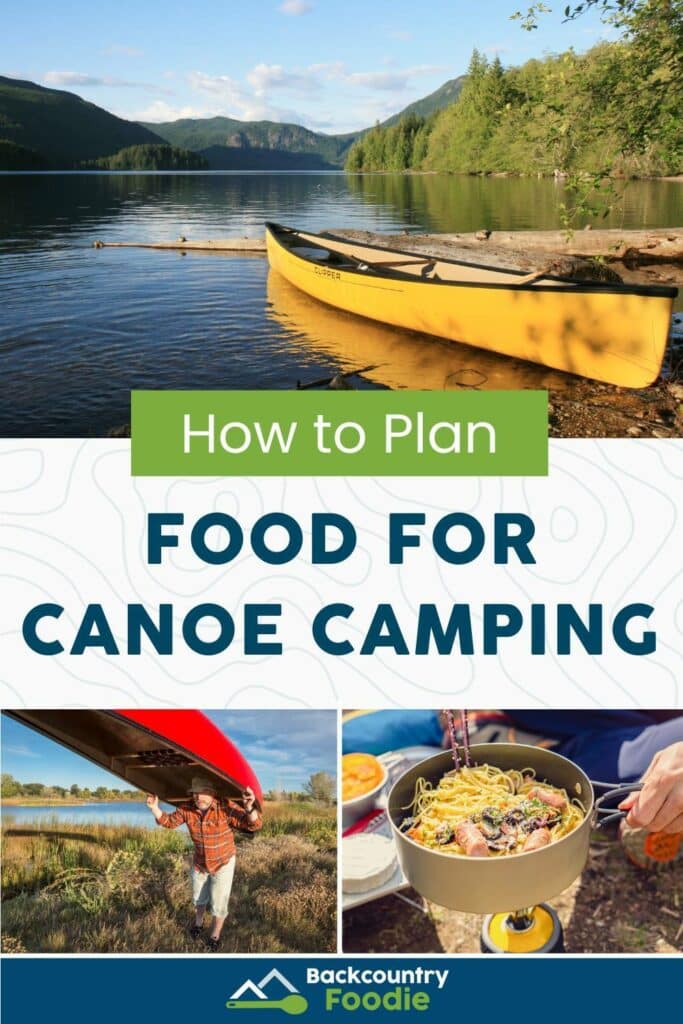
Are you new to our blog?
Consider checking out these posts:.
- Best Backpacking Foods for Energy
- What to Eat & Drink After Hiking: Our 3 Favorite Tips
- Backpacking Nutrition: Fueling Further Using the Goldilocks Approach
- Our Favorite 100 Grocery Store Foods
ABOUT THE AUTHORS:
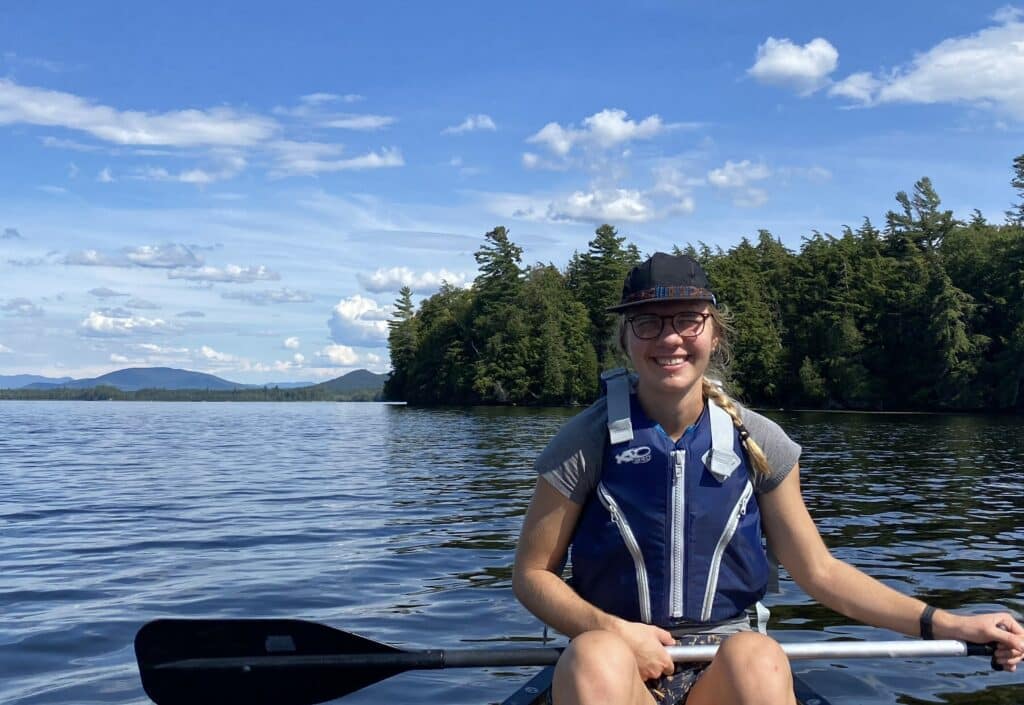
Sarah Coupal was a Dietetic Intern at Illinois State University mentored by Aaron when this post was originally written. She holds a BS in Nutritional Sciences from Cornell University and spent two summers as the Trails Food Coordinator for the Adirondack Mountain Club. She enjoys hiking/backpacking, canoeing, cross-country skiing, and running in her free time.
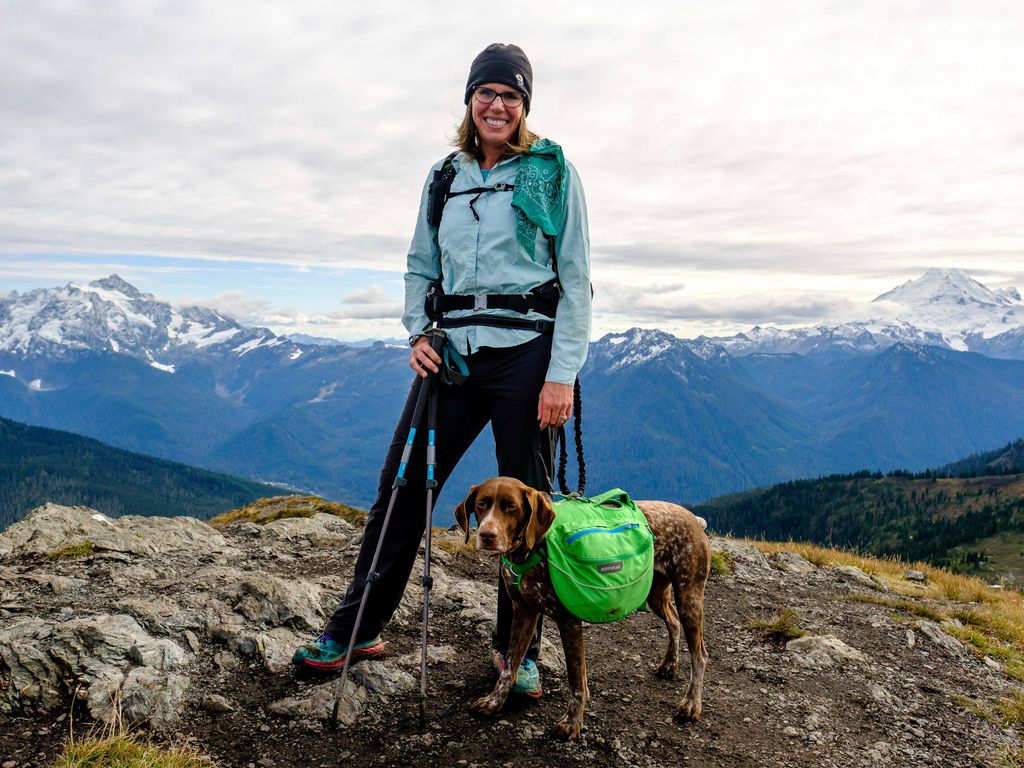
Aaron Owens Mayhew, MS, RDN, CD, is a registered dietitian and ultralight long-distance backpacker with over 20 years of nutrition and backpacking experience. She’s also the founder and owner of Backcountry Foodie , an online ultralight recipes and meal planning platform for backpackers. She also enjoys teaching hikers about backpacking nutrition via virtual masterclasses , YouTube videos , and podcast episodes . You can follow Aaron’s adventures in the kitchen and the backcountry via Instagram and Facebook .
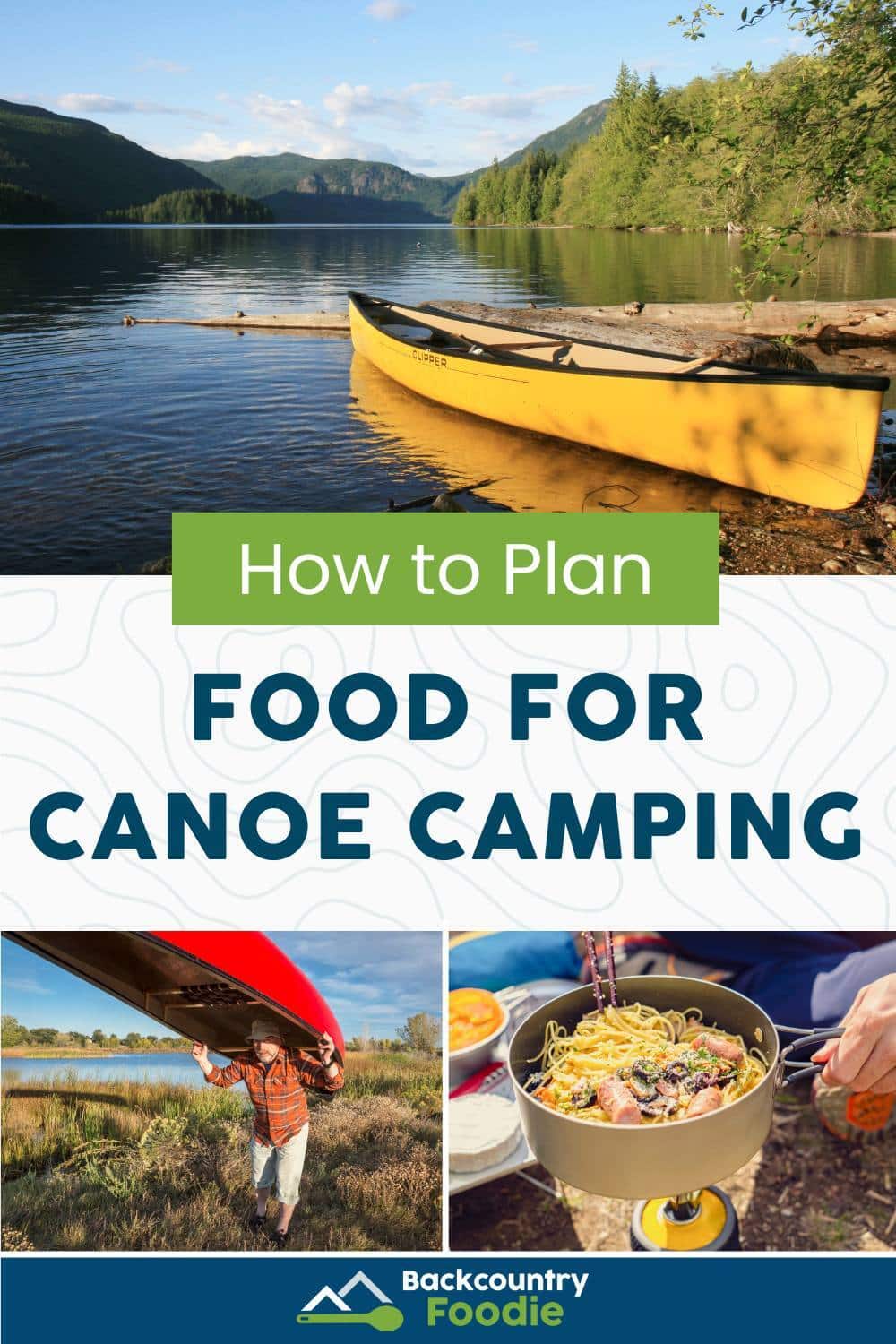
Leave a Reply Cancel reply
Your email address will not be published. Required fields are marked *
Save my name, email, and website in this browser for the next time I comment.
COMING SOON
Labor day sale.
Enjoy 20% off our memberships when you use coupon code LABORDAY20 at checkout!
Sale starts Friday, September 1st.
- 114 Pinterest
- 0 Copy Link

Canoe Camping Meals: Guide to Easy and Nutritious Options for Paddlers
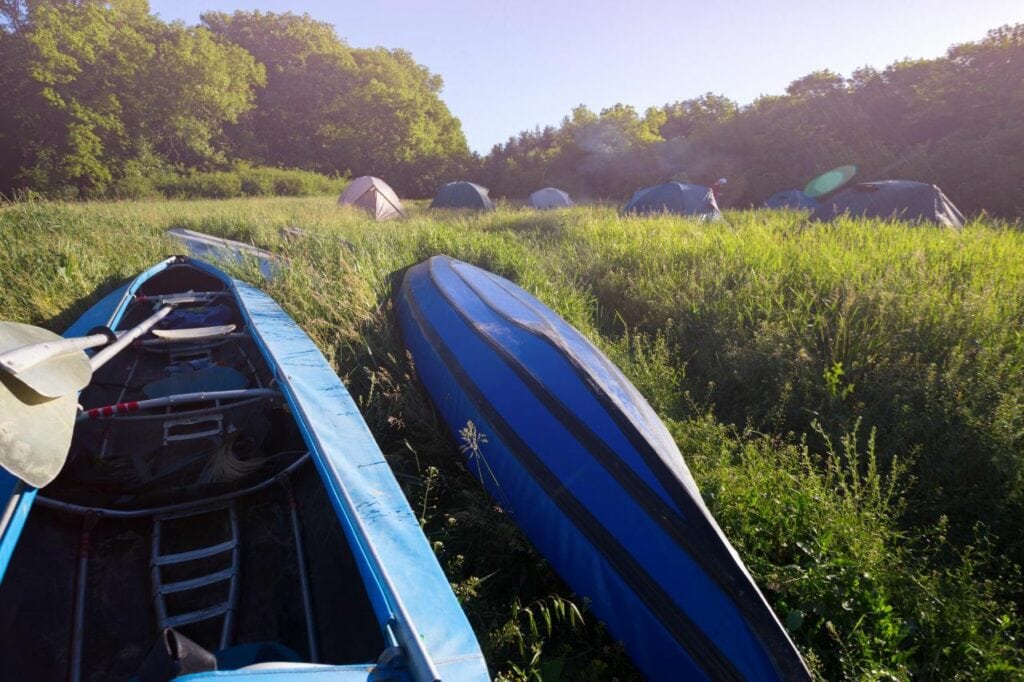
We're an affiliate. We hope you love the products we recommend! Just so you know, we may collect a share of sales or other compensation from the links on this page. Thank you if you use our links, we really appreciate it!
Going on a canoe camping adventure is a fantastic way to immerse yourself in nature while enjoying the tranquility of paddling through serene waters. One of the highlights during such excursions is the chance to delight in delicious and satisfying meals around a campfire by the shore. Backcountry cooking is an essential skill for canoe campers, and with a little meal planning, you can make sure to impress your fellow paddlers.
Canoe trip meals should be easy to prepare, delicious, and provide enough energy for your paddling adventures. Whether it’s breakfast, lunch, or dinner, having a variety of canoe camping recipes in your arsenal ensures that you and your companions can enjoy good food throughout your journey. From rehydrated meals to delightful one-pot dishes, there are numerous options to suit your taste and nutritional requirements.
When you embark on a canoe camping trip, remember that the paddle itself can be physically demanding. As such, it is crucial to choose meals that will keep you feeling invigorated and satisfied. With a bit of preparation and creativity, you can indulge in fantastic backcountry cooking experiences and turn your canoe camping adventure into an unforgettable culinary journey.
Preparing for a Canoe Camping Trip

Meal Planning for Canoe Camping
When planning meals for your canoe camping adventure, take into consideration your caloric needs, physical activity, weather, and duration of the trip. Aim to create a meal plan that provides a good balance of carbohydrates, proteins, and fats, with an emphasis on lightweight, non-perishable ingredients. Staples such as rice, pasta, and oatmeal can be combined with dehydrated vegetables, beans, and various proteins like jerky or canned fish.
Remember to pack some snacks for in-between meals, such as energy bars, trail mix, or dried fruits. Don’t forget to account for cooking oil, spices, and condiments to enhance the flavor of your dishes. Consider your dietary restrictions or preferences while creating your meal plan.
Packing Food for the Trip
Proper food storage and packing will ensure your meals stay fresh and lightweight throughout the trip. Use resealable plastic bags or airtight containers to pack your meals in portions while reducing bulk and potential food waste. Dry backpacking foods can be rehydrated with water directly in their containers, making them both space-saving and convenient.
For short canoe camping trips, you may prefer to bring some fresh foods, such as fruits, vegetables, or sandwiches. However, keep in mind that perishable items may spoil quickly, especially during warmer weather, so pack accordingly.
Cooking Gear Essentials
Assemble a lightweight and functional cooking gear set for your canoe camping trip. A compact camping stove, such as a canister or liquid fuel stove, is a great addition to your gear, especially in areas where open fire pits may not be allowed or where natural fire sources are scarce.
A portable fire pit can be an alternative cooking option if open fires are allowed at your campsite. Include a set of lightweight, durable pots, pans, or a Dutch oven for versatile cooking. Bring a spork, bowl, and a mug for each camper to use during meals.
Adhere to Leave No Trace principles by cleaning up all food waste and washing your dishes responsibly. Practicing proper backcountry camping ethics will help preserve these natural areas for future paddlers to enjoy.
Breakfast Ideas for Canoe Camping
Oatmeal and granola dishes.
Starting your day with a warm and hearty breakfast is important, especially during a canoe camping trip. Oatmeal is easy to prepare, customizable, and packed with energy. You can mix in various ingredients such as dried fruit, chopped nuts, brown sugar, and chia seeds to create your own unique flavor. Additionally, granola bars are perfect for a quick, no-cook option. Choose bars that contain a good amount of protein and healthy fats to keep you full and energized.
Egg-Based Meals
Eggs are a fantastic source of protein and can be used in numerous meals while camping. Breakfast sandwiches using powdered eggs, bacon bits, and sausage are a simple, filling option. Early in the trip, you can use English muffins, but for later meals, consider using wraps as a more portable alternative. If you want to level up your egg game, try creating a one-skillet dish by adding various ingredients such as vegetables, cheese, and cooked bacon or ham.
Portable Breakfasts
On busy mornings or when you’re in a hurry to break camp, portable breakfast options are a lifesaver. A favorite among campers are cinnamon buns—prepared in advance and individually wrapped, they make for a delicious handheld meal. Another option to consider is a savory calzone made with just-add-water pizza dough, pepperoni, and shelf-stable cheese, cooked over a campfire.
Warming up with a hot beverage is essential during those chilly canoe camping mornings. Don’t forget to pack coffee, tea, or hot chocolate to suit your personal preferences. If you enjoy milk in your drinks, powdered milk is a lightweight and non-perishable alternative. Pairing your hot drink with your breakfast meal will give you the energy you need to paddle your way through a busy day on the water.
Lunch Ideas for Canoe Camping
Sandwiches and wraps.
When canoe camping, you’ll want portable, easy-to-prepare lunches that don’t skimp on taste. Sandwiches and wraps are perfect for this. Stick with durable breads like bagels or tortilla wraps for maximum practicality. Fill your sandwiches with ingredients like cheese, hummus, or peanut butter, which last longer without refrigeration. Don’t forget to add a variety of veggies, like lettuce and tomato, for extra crunch and flavor. Always pack fixings separately to prevent soggy sandwiches that nobody wants to eat.
Quick and Easy Lunches
For busy canoe campers who don’t want to spend much time on food preparation, consider packing snacks that can be combined into a satisfying lunch:
- Crackers : Triscuits or other sturdy crackers pair well with cheese, hummus, or nut butter for a quick bite.
- Nuts and Trail Mix : A variety of nuts, along with a good trail mix, can provide valuable energy and satiate hunger when on the go.
- Beef Jerky : A high-protein snack that requires no preparation.
One Pot Meals
Sometimes, you’ll crave a hot meal in the middle of the day. One pot meals are perfect for simplifying your canoe camping lunch experience. Consider using a portable stove to whip up these delicious, easy dishes:
- Chili : Make a simple, delicious chili by cooking beans, canned tomatoes, and spices in one pot. You can even add dehydrated vegetables or meats to your chili for extra flavor and protein.
- Soup : Pack some instant soup mixes for a quick, light lunch option. Simply add water and cook in one pot. Try varieties like vegetable, lentil, or chicken noodle.
- Grain-based dishes : Quinoa or rice-based recipes make hearty, satisfying meals. Cook the grains in water and toss in a few dehydrated veggies, seasonings, or precooked meats. Stir everything together in one pot for a tasty, filling lunch.
Dinner Ideas for Canoe Camping

Hearty Dinners
When you’re on a canoe camping trip, nothing beats a hearty dinner after a long day of paddling. Here are a few options that are easy to prepare:
Pasta and Beans :
- Ingredients : pasta, canned beans, tomato sauce, olive oil, seasonings (salt, pepper, Italian herbs)
- Directions : Boil pasta according to package instructions. Heat up beans and mix with tomato sauce. Add olive oil and seasonings. Combine with pasta and serve.
Wild Rice and Lake Trout :
- Ingredients : wild rice, fresh lake trout (or other fish), olive oil, salt, and pepper
- Directions : Boil wild rice according to package instructions. Season the trout with salt and pepper, then wrap it in tin foil and place on hot coals. Cook until the fish is cooked through, and serve with wild rice.
Gourmet Canoe Trip Meals
Impress your fellow campers by elevating your cooking game with the following gourmet canoe trip meals:
Swedish Hardtack with Sausage and Cheese :
- Ingredients : Swedish hardtack, summer sausage, hard cheese, mustard
- Directions : Cut sausage and cheese into thin slices. Assemble on a piece of hardtack and top with mustard. Enjoy the gourmet taste in the great outdoors.
Vegetable Stir-Fry :
- Ingredients : rice, a variety of vegetables (e.g., carrots, zucchini, bell peppers, mushrooms), olive oil, soy sauce, ginger, garlic
- Directions : Cook rice according to package instructions. Chop vegetables into small pieces. Heat oil in a pan over the campfire, add vegetables, and cook until tender. Add soy sauce, ginger, and garlic. Stir-fry for a couple more minutes, and serve over rice.
Campfire Cooking
Cooking over an open fire adds an enjoyable and tasty element to your canoe camping experience. Here are a couple of simple options:
Bacon-Wrapped Sausages :
- Ingredients : sausages, bacon
- Directions : Wrap each sausage with a slice of bacon. Slide a stick through both ends of the wrapped sausage. Hold or prop the stick over the fire pit until the bacon is crispy and the sausage is cooked through.
Fire-Grilled Vegetables :
- Ingredients : your favorite vegetables (e.g., bell peppers, zucchini, mushrooms, onions), olive oil, salt, and pepper
- Directions : Chop your choice of vegetables into large pieces. Toss in olive oil, and season with salt and pepper. Create little foil pouches and seal the vegetables securely. Place flat on hot coals to cook, flipping occasionally, until tender.
Snack Ideas for Canoe Camping
While out on a canoe camping trip, it’s essential to have a variety of snacks to keep your energy levels up. Here are some delicious and easy-to-pack options for your next adventure.
Nuts and Trail Mix: Nuts are a fantastic source of protein and healthy fats. Bring a variety of your favorite nuts such as almonds, cashews, and walnuts. You can also make your own trail mix by combining nuts with dried fruits like raisins, cranberries, or apricots. For extra indulgence, throw in some chocolate chips or M&Ms.
Beef Jerky: For a protein-packed snack, beef jerky is an excellent choice. It’s lightweight, delicious, and comes in many different flavors. You can even find vegan and vegetarian options made from plant-based proteins.
Granola Bars: Granola bars are a tried-and-true canoe camping snack. Look for those made with whole grains, nuts, and dried fruit for maximum nutrition. If you’re feeling creative, you can even make your own before the trip by mixing together oats, nuts, dried fruit, and a sweetener like honey or maple syrup.
Fruit: Fresh fruit may not be practical for long trips, but it’s an excellent addition to your snack rotation for shorter outings. Apples, oranges, and bananas are great choices that can withstand rough handling. For longer journeys, opt for dried fruit like raisins, cranberries, and mango.
Chocolate: Don’t underestimate the mood-lifting power of chocolate! Pack a bar or two for those moments when you need a little pick-me-up. Keep in mind that chocolate can melt on hot days, so consider packing chocolate-covered nuts or treats that are more temperature-resistant.
Incorporate these snacks into your canoe camping meal plan to ensure you have plenty of tasty options throughout your trip. Remember, maintaining your energy levels is crucial to enjoying your adventure and staying safe on the water.

We’re passionate about getting the most from your car when it comes to going on adventures and road trips. When you take one of these trips you often need more room in your car than you usually would. This is when we come in, to help you find the best roof tent for your car and needs.
Leave a Comment Cancel Reply
Your email address will not be published. Required fields are marked *
- Kayak Accessories
- Kayak Paddle
- Fishing Kayak
- Inflatable Kayak
- Recreational Kayaks
- Touring Kayaks
- Whitewater Kayak
- Safety and Navigation
- Paddling Gear Awards
- Beginner Paddling Skills
- Intermediate/Advanced Skills
- Outfitting and Accessories
- Health and Fitness
- Paddling Adventure
- PaddleTV Channel
- Clothing and Footwear
- Tents and Sleeping Gear
- Trail & Camp Gear Awards
- Trail & Camp Learning
- Trail & Camp Adventure
- BackpackingTV Channel
- Family Adventure Reviews
- Family Adventure Tips
- Family Adventure Stories
- Family Adventure Awards
- Adventure Fishing Reviews
- Adventure Fishing Learning
- Adventure Fishing Trips
- OE Trip Journals
- Adventure Journals

When planning for a longer canoe camping trip, I would go as far as to say that nothing is more important than food and meal planning. A boat stocked with generous supplies of delicious grub can make the difference between a fantastic outdoor experience, and one that leaves you longing for the comforts of home.
So today I want to give you a sample meal plan for a 5-day canoe camping trip with multiple portages. My advice for planning meals on a canoe trip could be something that you can use as a baseline reference. Adjust it and personalize it to make your canoe trip a success.
Packing food for an extended canoe camping trip
Before you get underway, there are a few environmental factors that will dictate how you should pack for a canoe camping trip. For example, does your route entail a lot of portages or is it mostly long paddles between campsites?

One of the benefits of a canoe trip over a kayak or a backpacking adventure is that you can chuck in a lot of bulky and bonus items. However, if you need to repeatedly lug all of that overland, then that prior advantage becomes more of a nuisance.
Multiple portages means lighter foods
So if your trip does involve multiple portages, I recommend sticking with lighter, more packable foods. If you're set up to predominantly paddle, then go nuts with those luxury foods and bonus treats.
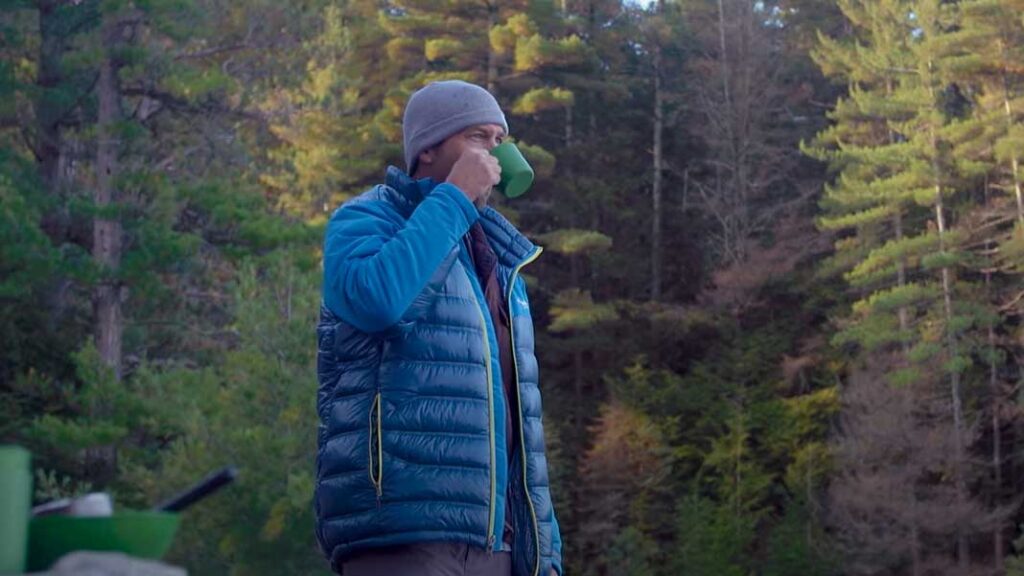
Weather is important for food planning
Another environmental factor to consider when canoe camping (as best as you can in advance) is the weather. Namely, how hot will it be? This will determine the shelf-life of different foods. If it's a scorching hot summer trip, then maybe scale back on the packaged meats. But if it's a cooler area or time of year, then you can get away with a lot more.
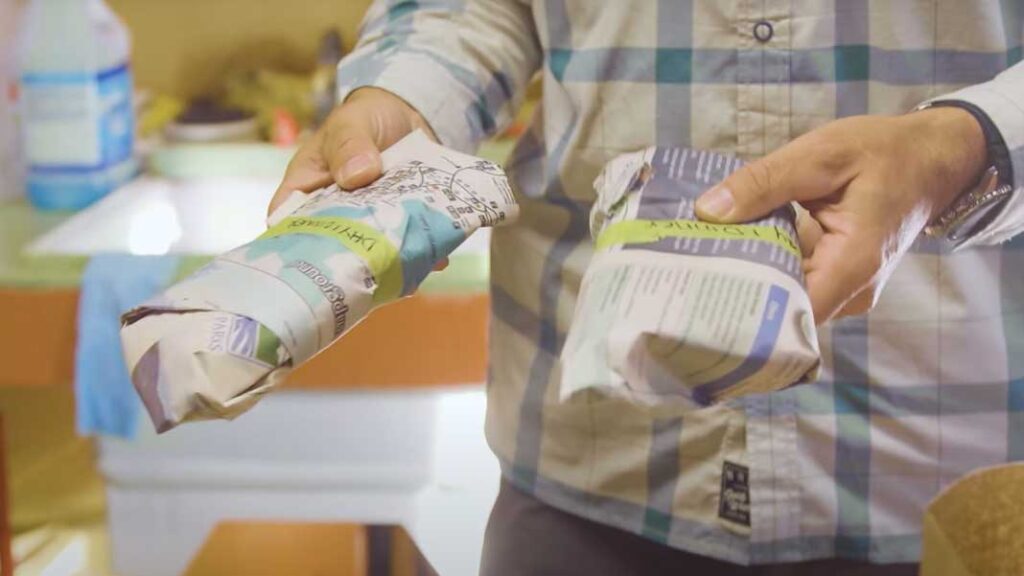
As a general rule, I like to pack more fresh foods for the first 2 days, and then I'll switch over to pre-packaged and dehydrated stuff, just to be on the safe side.
Calories you burn on a multi-day canoe trip
And a final thing to consider is how many calories you and your crew expect to burn. Is this a poke along and smell the roses kind of affair, or is it an ambitious, cover a lot of ground type deal?
In the case of my reference 5-day canoe trip, my buddy and I planned to do a lot of hard paddling, in cold and windy conditions, while also banging out several challenging portages.
4000 calories a day per person
Taking all of this into consideration, we determined that we would need about 4,000 calories per day per person.
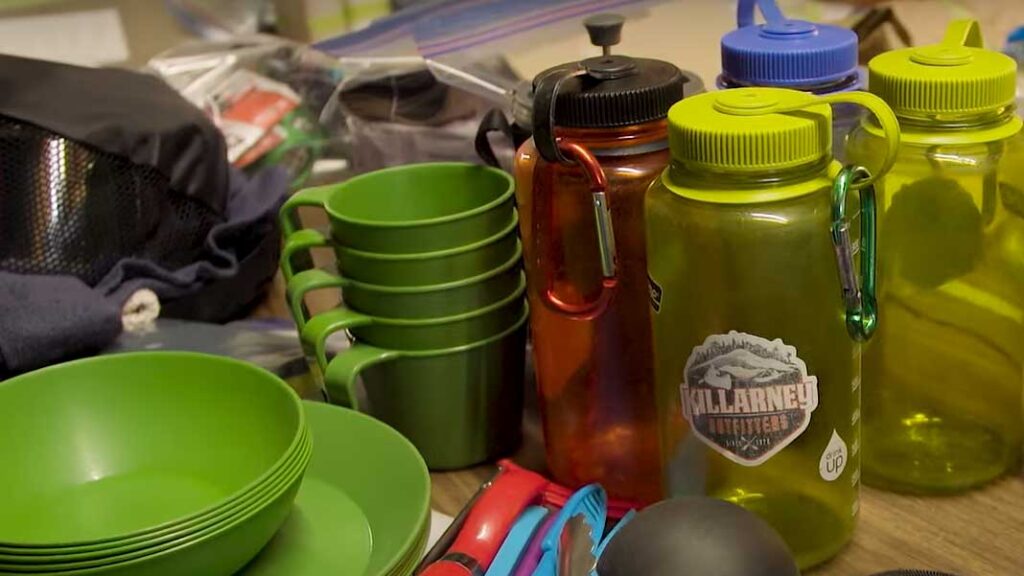
What should I eat on a canoe camping trip?
Now that we've covered some general considerations, let's dive into a 5-day sample meal plan. For this trip, our campsites all included firepits with those built-in grill grates, and so we planned to do a lot of our cooking over open flame (particularly in the evening). But we also packed lots of fuel for our classic camping stoves.
Meal Plan for Canoe Camping Day 1
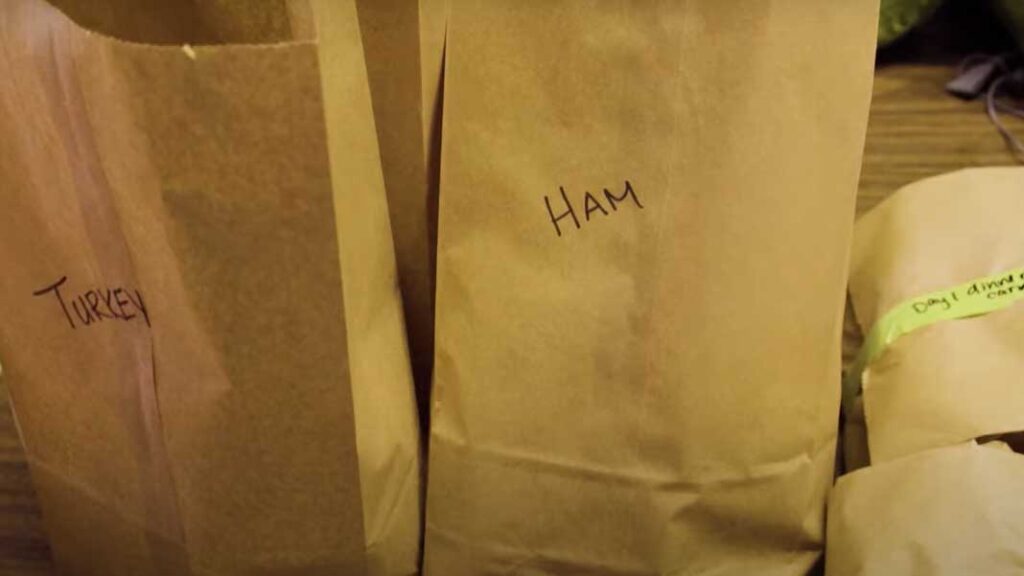
Breakfast : Consumed on shore before pushing off
Lunch : Pre-made sandwiches, chips, and a piece of fruit (classic school lunch)
Dinner : 4 frozen/wrapped steaks, baked potatoes, and mushrooms
Meal Plan for Canoe Camping Day 2
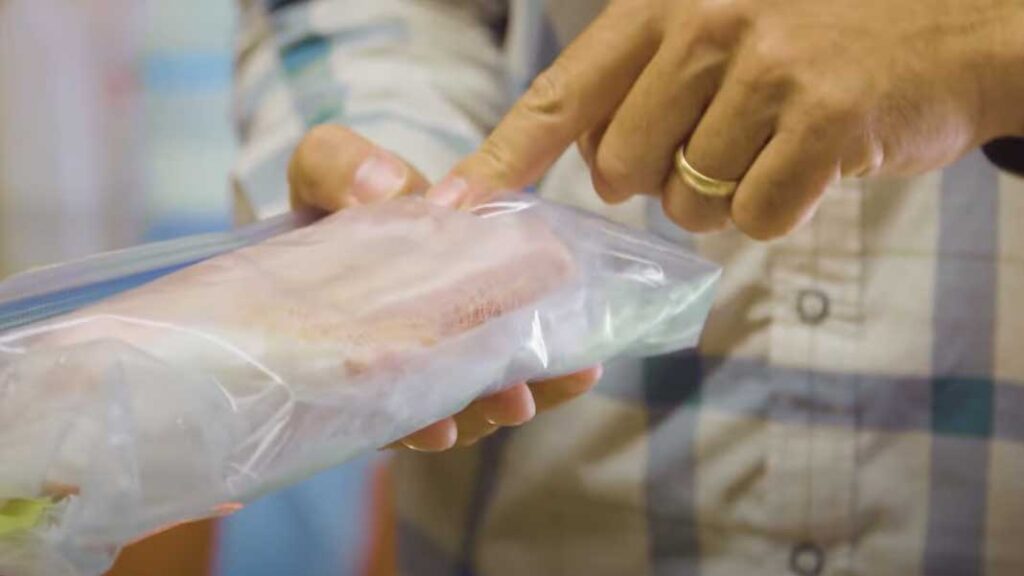
Breakfast : Bacon (wrapped in vinegar-soaked cheesecloth for preservation purposes), eggs (see note below), and fresh bread
Lunch : “Trail lunch” for anticipated portages (i.e. trail mix, cheese/crackers, granola bars, beef jerky, peanut butter/jam).
Dinner : Frozen beef chili sealed in Ziploc bags and wrapped in newspaper
Meal Plan for Canoe Camping Day 3
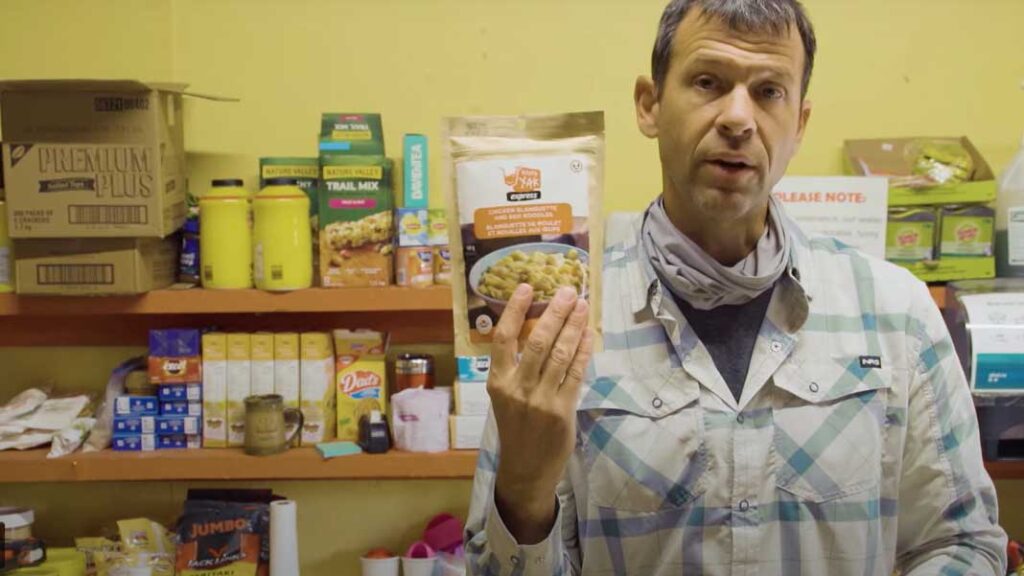
Breakfast : Instant oatmeal w/ dried fruit (raisins, blueberries, banana chips, etc.)
Lunch : Salami and cheese tortilla wraps (meat and cheese also wrapped in vinegar-soaked cheesecloth) + celery/carrots
Dinner : Dehydrated mac and cheese
Note: Although many camping meals say they are good for 2 people, in reality, after a day of hard paddling or trekking, most people seem to like a full package to themselves.
Meal Plan for Canoe Camping Day 4
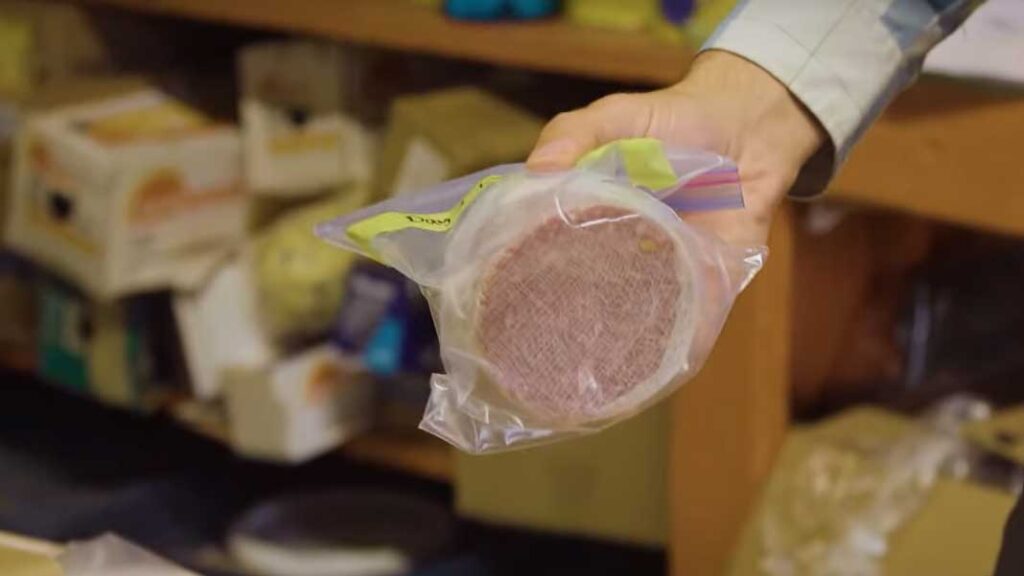
Breakfast : Instant oatmeal w/ dried fruit
Lunch: Salami and cheese but this time on pita bread rather than tortillas + celery/carrots
Dinner: Dehydrated pad thai
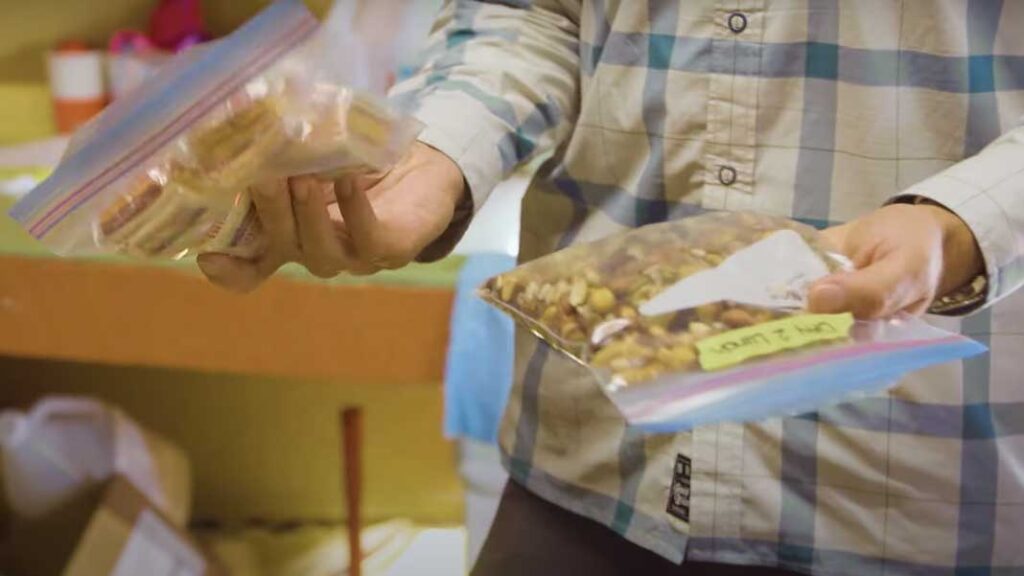
Meal Plan for Canoe Camping Day 5
Breakfast: Instant oatmeal w/ dried fruit
Lunch: Same as day 4
Dinner: Dehydrated meal (whatever flavor is left after the group picks them over for 3 nights)
Extra Snacks throughout the trip:
Trail mix, cookies, brownies, fresh fruit (for the first few days), pepperettes, popcorn, tea/coffee
Can you bring eggs on a canoe trip?
You may have noticed my inclusion of eggs in the meal plan and wondered if that's ok to do. Eggs are a great source of protein, and they're super easy to cook up, so I love bringing them along.
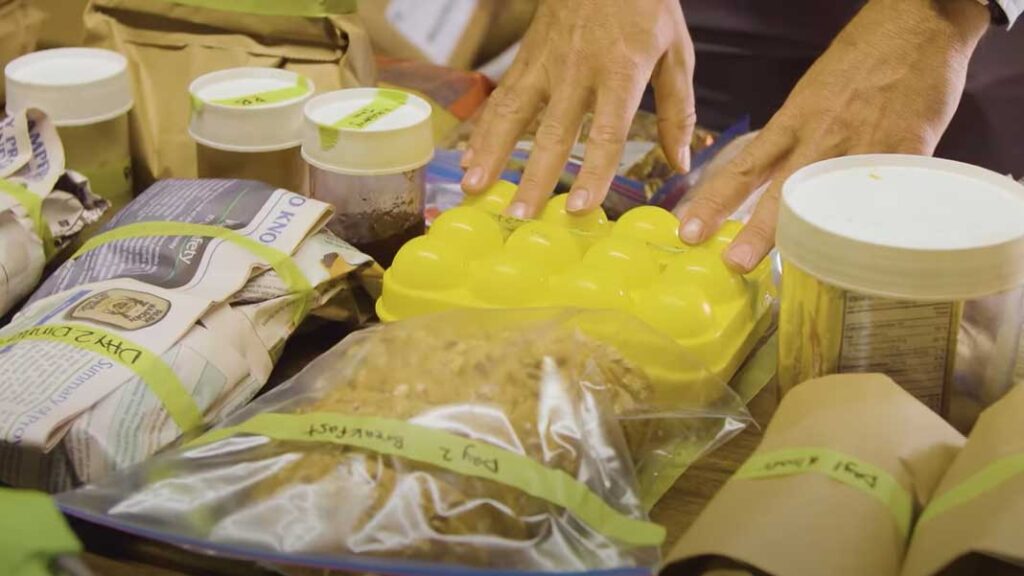
The trick is keeping them protected, which can be done by getting one of those hard plastic egg cartons that you can find in any home/kitchen section of a big box store.
Our friends at Killarney Outfitters also blanched our eggs in advance, meaning they briefly dropped them in boiling water in order to kill all the bacteria on the shells. This helps extend the shelflife out in the wild.
Shout out to Killarney Outfitters!
All of these tasty and strategically planned meals during our canoe camping trip were laid out for us by Killarney Outfitters . I love working with them anytime I'm in the area, and since Killarney Provincial Park is one of my favorite places to paddle, we've gotten to know each other rather well over the years. They are so well-stocked and familiar with the area that you can essentially just show up with a toothbrush and a change of underwear, and they'll fix you up with the rest.
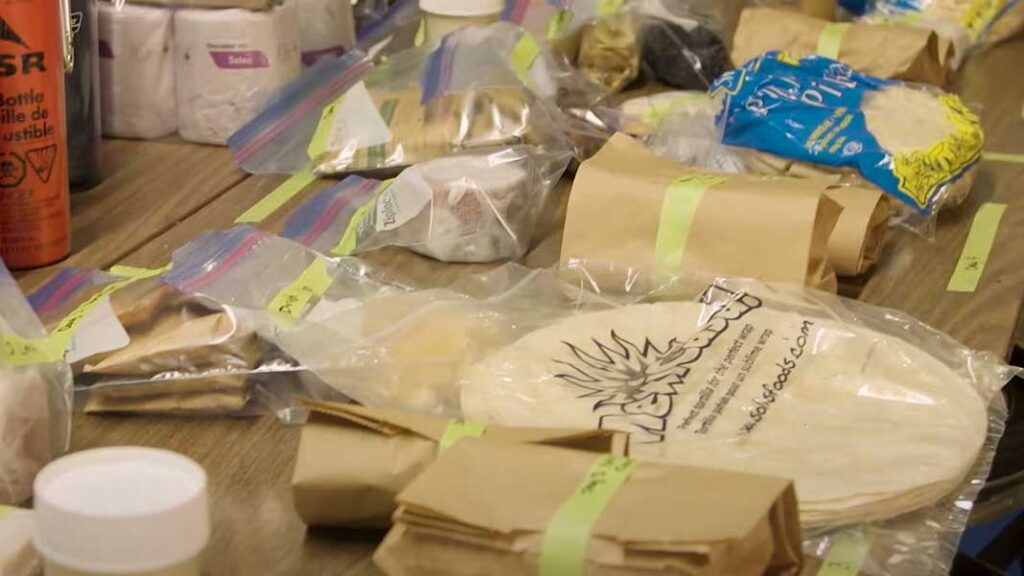
I hope all this talk of camping food has you chomping at the bit for your next canoe trip. Each person and each excursion is a little different, but this should give you some idea of what to pack, and what to skip over. For more paddling tips, gear reviews, and to share in the adventures, make sure to follow along with PaddleTV and subscribe to the In4Adventure newsletter .
- canoe camping
- canoe trips
- meal planning
Related Articles
Adventures around sacramento: a hidden gem in california, hammock tent camping – eno doublenest review, discovering montréal’s winter wonderland: a tapestry of experiences, our paddling community, ken whiting: paddling.
More Reviews
Oru kayak coast xt kayak review, kayaking ireland’s wild atlantic way, kayaking in lapland, finland, top paddling gear of 2023; a holiday gift guide, best kayaks and canoes of 2023.
MY GLOBAL PARTNERS! Special thanks to my Global Partners for supporting my mission of helping get people on the water and creating life-long outdoor participants.

Be sure to check out our product recommendations and related blogs posts after the article!
Going on a canoeing camping trip is one of the most exciting and adventure-packed ways to experience the Great Outdoors, not to mention the fact that it’s an excellent way to reconnect with your friends and family. However, if you want your paddling trip to be truly enjoyable — you need to be prepared!
To prepare properly for canoe camping, you need to think about what you’re going to eat along the way. And that’s precisely why we’ve decided to provide you with a couple of excellent canoe camping recipes for your next trip.
Easy Meals and Snacks to Try on Your Next Paddling Trip
Canoe camping breakfast idea.
When you’re preparing your canoe camping meals, you’ve essentially got three priorities — as with any other meal, you want them to be decently tasty. Apart from that, they also need to be easy to make. You don’t want a fiddly meal when you’re in nature. Then, most importantly — it needs to provide you with all of the nutrition you need for all of the physical activity you’re going to have on the trip.
That’s why your breakfast should be a healthy classic: Date Maple Nut Oatmeal
For this recipe, you need:
- 3 teaspoons of dates (chopped)
- Half a cup of walnuts
- 3 teaspoons of maple sugar
- One cup of instant oats
If you don’t want to go with instant oats, you can make your own by powdering oats in your blender. And after you’ve gathered these ingredients, you’ll pretty much have your breakfast ready. All that remains in terms of preparation is combining all of the ingredients in a bowl and pouring a cup of boiling water over them; after stirring for a couple of minutes, let the oatmeal sit and cool for a bit.
Depending on how thick you like your oatmeal, you’re free to adjust the amount of water. Also, unlike most of the other meals we’ve listed here, this one isn’t protein-heavy; though, you could add some almond butter if you feel like you want a protein-laced breakfast as well.
Canoe Camping Lunch Ideas
There are plenty of people who pull off amazing cooking feats in nature, but we’re going to avoid anything too difficult for your lunch. After all, there’s still quite a lot to do during the day when lunchtime comes around, and you don’t want to waste time and effort on extensive cooking. That being said, there are some great camping meals you can make for lunch without trying too hard.
Once lunchtime rolls around on your canoe camping trip, you’re going to want something packed with protein and other nutrients but without the need for extensive preparation. That’s why we recommend a meal that takes some prep before the trip, but almost none while you’re out in nature: Camp Tacos!
To make camp tacos, you need:
- Crushed tortilla chips
- Pre-cooked taco meat
- Cheddar cheese
- Shredded lettuce
- Sliced tomatoes
Apart from getting the ingredients, you’ll need to cook your favorite taco meat before the trip and keep it in appropriate canoe camping food storage. For those more inclined to vegetarian or vegan diets, you can always use vegan sour cream and another protein source. While tofu is the go-to option for many, these tacos go exceptionally well with some black beans — an excellent protein source that’s also a common staple in Mexican cuisine.
For the next lunch option, if you’re willing to prepare this before the trip itself, you’ll save a lot of time on food prep while you’re in nature itself. The famous Swedish Hardtack is one of the many granola-Esque lunch meals that are easily stored on camping trips and nutrient-packed enough to allow you to make it until dinner without feeling hunger.
To make Swedish Hardtack, you’ll need:
- 1 teaspoon salt
- 5 cups of rye flour
- Half a cup of cooking oil
- Half a cup of honey
- 2 cups of yogurt
The preparation itself isn’t too complicated. First, mix all of the ingredients into a bowl and proceed to knead them until you’ve got a dough with a uniform texture and smoothness. Then, leave it in the refrigerator for about an hour.
The number of ingredients above should yield you about a pound of dough. If you want to get nice, even crackers, we recommend rolling this dough to a square with a 16-inch diameter. Then, proceed to trim the edges to achieve the right shape and use a knife or pizza cutter to cut individual crackers.
Place the crackers on a cookie sheet and bake them for 15 minutes at 375 degrees F. After this, they should start browning — that’s when you can pull them out of the oven if you want to avoid them being brittle.
Voila! Now they’re ready to be stored in foil and a plastic bag. This is the perfect lunch for a long canoeing trip that doesn’t require you to do much in nature itself.
Canoe Camping Supper Idea
You can handle a more involved preparation process for supper, seeing as the day is pretty much winding down. And in the case of this camping meal, we’re going to give you an option that you can cook both on a camp stove and a campfire.
One of the classic staples of the American household — but with a camp twist: Campfire Spaghetti. We’ve provided the ingredient amounts for three servings, but you can adjust for more if you’re taking more people on your trip.
To prepare the best campfire spaghetti, you need:
- Your preferred spices
- 8 oz of spaghetti noodles (dried)
- Parmesan cheese
- Previously prepared spaghetti sauce
- 1 lbs of lean ground beef
You’ll have to make a part of this meal at home, but it’s nothing too tricky. You need to cook your ground beef until it gains a distinct brown color. Then rinse and drain until all of the fat is gone, and use a dehydrator or a classic oven to dry it completely; it should have a grape nut consistency after you’ve finished. If you are vegan or vegetarian, sub the ground beef with dried TVP (textured vegetable protein) crumbles.
If you want this meal to be as quick as possible, you can get a jar of store-bought tomato sauce. Otherwise, stir-fry the tomatoes with some olive oil, onions, and paprika (which you can leave out if you don’t want it to be too spicy). If you want the sauce to last you as long as possible, use a dehydrator to bring it to a fruit leather consistency.
After this, you need to place the ingredients in baggies — separating the beef, parmesan cheese, and the sauce. Don’t forget to bring your spices as well!
When you’ve got your campfire or camp stove going, start heating a bowl of water over it. When it’s at boiling point, separate the ingredients into cups and begin adding water slowly. Once you notice that the beef and the sauce have reached the proper consistency, you can add the noodles and cover the bowls or cups with a lid or a plate.
Give it a couple of minutes, and the noodles will be cooked. Then, all that’s left is to add your choice of spices and the parmesan cheese (vegans can sub the cheese for nutritional yeast).
Canoe Camping Snack Ideas
In between all of the meals above, you want to have a steady supply of snacks that can quench hunger without having to stop what you’re currently doing or prepare a meal. The last thing you want in this case is junk food. When you’re in nature, you need something with real nutritional value, snacks that will truly keep you going until the next meal comes around.
For such purposes, you can’t go wrong with a good nut mix. This is the healthiest nutrition-rich snack you can take with you, and it’s not like it takes up a lot of space. Nuts are rich in (healthy) fats and can fill you up for a couple of hours until you make lunch or supper. They give you an excellent balance of fiber, protein, and healthy fat, and seeing as they need no refrigeration, they make the perfect camping snack. Add some dried fruit for an extra boost of energy and sugar as well.
If you are bringing your kids with canoe camping, don’t forget to pack the s’mores either! This is a classic sweet treat sure to make anyone a happy camper.
How to store and pack food when canoe camping
One of the most innovative ways to approach canoe camping is to plan everything out thoroughly. So, after booking a guided tour that leaves nothing up to chance — you can also plan out all of your meals extensively.
When you do that, you can store all of the ingredients; the dry stuff can go in separate baggies, while fresh ingredients will need to go into a cooler. Depending on the length of the trip and the meals you’ll prepare, you may need to freeze some meat — in that case, make sure you’ve got a separate cooler for the meat and the fresh vegetables to maintain the temperature of the frozen ingredients when you take out the unfrozen stuff.
Be sure to check out our product recommendations and related blogs posts below!

Check out our selection of curated, premium buschraft products - the same ones we use in the field!

We are continually adding to our database of useful articles about camping, bushcraft, and nature connection.

Give us a shout! We're happy to discuss any questions, comment or concerns about our trips, custom classes, or gear.
- Recreational Day Trips
- Longer Touring Excursions
- Straight Shaft
- Solo Canoeing
- Recreational Fishing
- Longer Fishing Excursions
- High-Visibility
- Hook Retrieval
- Versa-Lok Ferrule (Adjustable)
- Snap-Button (Fixed Length)
- All Sale Paddles
- New Arrivals
- All Apparel
- Accessories
- Cosmetic Seconds
- All Sale Items
- Bending Branches Team
- National ProStaff Team
- Regional Ambassador Team
- Wood Paddle Care
- Composite Paddle Care
- Factory Tours
- Canoe Sizing Guide
- Solo Canoe Sizing Guide
- Pack Canoe Sizing Guide
- Kayak Fishing Sizing Guide
- Kayak Sizing Guide
- Rockgard® Edge Protection
- Bent vs. Straight Paddle
- Paddles for the Solo Canoeist
- Versa-Lok Ferrule System
- Snap-Button vs Plus Ferrule
- Plus Ferrule System
- New At Bending Branches
- Black Pearl ST
- Dealer Locator
- Paddle Finder
- instagram Instagram
- twitter Twitter

- Learn Blog FAQ's Cosmetic Seconds Wood Paddle Care Composite Paddle Care Factory Tours Paddle Sizing Canoe Sizing Guide Solo Canoe Sizing Guide Pack Canoe Sizing Guide Kayak Fishing Sizing Guide Kayak Sizing Guide Choosing a Canoe Paddle Rockgard® Edge Protection Grip Guide Bent vs. Straight Paddle Paddles for the Solo Canoeist Choosing a Kayak Fishing Paddle Versa-Lok Ferrule System Snap-Button vs Plus Ferrule Plus Ferrule System Product Highlights New At Bending Branches Black Pearl ST
Canoe Trip Food: What Are Your Options?

8-minute read
By Sharon Brodin
A multi-day canoe trip is a unique wilderness experience that, like backpacking, means you pack your food wherever you go. Let’s look at your options for canoe trip food so you can make the best choices for your group and situation.
When it comes to canoe camping meals there’s no right or wrong. Some people want light and easy meals. Others want gourmet. Some love camp cooking, others just want to have a full belly. What you decide will depend on quite a few factors including whether you're planning long trips or shorter trips.
There are three basic options when it comes to meals for your wilderness canoe trip: “real” food (non-dehydrated), pre-packaged dehydrated meals marketed to backpackers, and DIY dehydrated meals.
There are pros and cons to each of these:
Bring “Real” Food
PROS: Tastes great • healthy • budget-friendly
CONS: Heavy • Takes up more room in the pack • somewhat labor intensive to plan and prepare both before and during the trip
BEST FOR: Trips with little to no portaging • short trips • strong portagers • fresh food lovers
Back in the 80s when I was a camp counselor in northern Minnesota, we brought teens on 5-10 day canoe trips in the Boundary Waters. In those days—at least at low-budget small ministries like ours—expensive pre-packaged backpacking food wasn’t an option (I’m not sure it was even on the market at the time).
We brought “real” food along on these trips. We had a food pack it all fit in, including the cook kit. It was our heaviest pack at the start of each trip and of course would lighten up after every meal.
When our family (my husband and I, plus our three teens) joined another family (with a husband, wife and their teen) for a 5-day trip a few years ago, we also brought mostly “real” food. We weren’t too worried about the weight because we had four healthy teenagers to help with the portaging!
We even packed in our griddle so we could have pancakes one morning:

The way our boys could eat, it would’ve cost us a fortune to buy pre-packaged backpacking meals. Each one of them could’ve eaten an entire 4-serving meal alone!
More examples of real food that works well in the right packaging are instant oatmeal, pita bread, ground beef (cooked ahead of time and frozen) and rice cakes.
Buy Pre-Packaged Dehydrated Food
PROS: Lightweight • easiest way to prepare on the trail with little time needed for food preparation
CONS: Expensive • sometimes sketchy flavor
BEST FOR: Extended trips • lots of portages and/or long portages • solo or small groups
Your easiest meal planning option for both packing and preparing is to buy pre-packaged dehydrated meals. There are many brands out there that make and sell these, including small family businesses. Many carry gluten-free and vegan options.
If you’re short on prep time and have the budget to spend more on each meal, this is your best option. It’s very lightweight, it’s easy to plan, and easy to prepare on the trail.
Taste varies, even among different meal options with the same brand. Although when you’re in the wilderness and have been paddling and portaging all day, most of us aren’t too picky about our food anymore. Everything tastes good!
One thing I noticed that some of you will want to be aware of: these meals meant for backpacking tend to be loaded with saturated fat, carbs and calories. I suppose they're designed for through-hikers and others burning a lot of calories every day. That may be true for you on an extending paddling trip…but personally, the last thing I want to do on a canoe trip is gain weight!

Make Your Own Dehydrated Food
PROS: Budget-friendly • lightweight • custom meals • easy to prepare on the trail
CONS: Time and labor-intensive to prepare before the trip
BEST FOR: Foodies • those with time beforehand • extended trips and/or lots of portages
Finally, if you have the time and desire, you can make your own dehydrated meals before your trip.
My brother-in-law, Thaddeus, loves dehydrating his own canoe trip food. He’s done it for a few canoe trips now, so I asked him for his best tips:
“The site that got me going on making my own is TheYummyLife.com , although Fiesta Rice was one we had to choke down—whew, a little over-spiced! Then I ordered the book The Backpacking Chef and riffed off the two of them from there. “ Chef has good ideas for sauces and soups that can provide a base for other things. You can make sauces, like spaghetti sauce and soup base, and dehydrate it into “leather” for light, easy packing. When you’re in camp, just add it back into the pot of whatever you’re making. It opens up a whole world of flavor with camp food!"
Thaddeus and his nephew have done trips as long as nine days and have been able to fit most of their meals into a 10-liter dry bag.

You can get away with ordering freeze-dried mixed veggies, and then find the other ingredients at your local grocery store. But you won’t save much money that way. To really get into it (especially for sauce leather, scrambled eggs, etc.) you’ll want your own dehydrator.
A side note: If you’re going to make it, make it in batches. The shelf life of dehydrated food is incredible, so make a whole season’s worth at a time…or even a couple year’s worth at a time. Stored properly, it’ll last.
What About Beverages?
One of the handy things about canoe tripping is you'll never run out of water sources. Instant coffee, tea, hot chocolate and Tang are all good options for beverages on-trail. Anything instant is easiest since all you need is hot or cold water.
Back in my flavored cream days, I tried this interesting little item (on the left):

It was pretty nasty—both the gooey texture and the taste. I don’t recommend it!
When you’re used to fresh-ground coffee, the instant isn’t fantastic—even Starbucks. But it’ll do if it’s easy you’re after. Some of it comes premixed with powdered milk if you like cream in your coffee like I do. If you’re determined to have fresh coffee that's certainly possible as long as you don’t mind packing a little more.
Incidentally, you can drink Tang cold or hot. Back in camp days, we brought a mixture we called Russian tea, with instant tea and Tang, plus cinnamon and cloves. (The recipes I looked up all call for sugar, too, but Tang is sweet enough for me.)
Easy-to-Pack Snacks and Lunches
Individually-wrapped protein and granola bars, dried fruit, nuts, trail mix, peanut butter on tortillas or Rye Crisp, summer sausage, beef jerky. All are easy, economical and packable. Don’t forget a utensil to spread and cut.
Foods like fresh fruit, cream cheese and fresh vegetables are options, but best used early in the trip. That way your pack weight goes down quickly and nothing has a chance to spoil.
On one recent trip, the person providing lunch on Day 1 brought frozen homemade brownies. They were unthawed by the time we stopped for lunch without getting crushed along the way. They also helped keep the lunchmeat cold in the meantime…and they were responsible for huge smiles on our faces!

More Thoughts & Tips on Canoe Trip Food
TIP #1: Plan a combo of real food and pre-packaged. Grocery store brands like Bear Creek offer dry soup and rice mixes with everything but the meat. Pack along real protein and you have a hearty meal for half the price of the backpacking meals.
Or bring some backpacking meals and some DIY, along with some real food. It doesn’t have to be all-or-nothing.
TIP #2: Organize by day and meal: Put all the menu items for each meal in separate ziplock bags and label them—Breakfast Day #1, Lunch Day #2, etc. Load the food pack starting with the last day’s bags at the bottom.
This is an especially great system if you bring perishables like frozen pre-cooked hamburger that you want to eat early in your trip. Use the empty Zip-locks to store all your trash.
TIP #3: One of the tricky parts of planning is to decide the amount of food to bring. You don’t want too much because there’s no way to deal with leftovers. You don’t want too little because you’re working hard out there, will build up hearty appetites and need the calories.
You need to know each person in your group and guess how much food they’ll eat. Teen boys will eat a lot more food than older women like me. The foods listed above under the snack section don’t take up much room and can supplement hungry people who didn’t get enough for dinner.
TIP #4: If time is gold for you and money is no object, work with an outfitter near your entry point to provide the trip food for you. They’ll plan, prepare and pack it in a food pack or canister(s) along with a cook kit. All you have to do is pick it up. Super easy and convenient. Many outfitters offer this kind of a la carte option even if you have all your own gear.

TIP #5: Be sure you know any regulations about the area you’re traveling in. For example, you’re not allowed to bring metal or glass containers into the Boundary Waters, which means no canned food.
TIP #6: Don’t forget extras like spices, olive oil, maple syrup and other you may want. How will you package them so liquids won't escape?
TIP #7: If you’re in bear country you’ll need a tree big enough to handle the weight of your food pack when you string it up for the night. Think about this when you choose your campsite. And don’t forget rope! A pulley system works really well for heavy packs, especially.
Of course, you can also use bear canisters instead of a traditional canoe pack. I’ve heard varying opinions on whether they’re actually bear-proof (it might depend on the bear!).
TIP #8: Do you plan to harvest some of your trip food—like ripe berries and fish? That’s awesome. Of course, berries depend on the season and you may want to have a back-up plan if the fishing isn’t great.

TIP #9: Will you cook over a campfire or camp stove? That’s a whole other topic, but to be succinct: For a large group, you can cook more food over a campfire at one time, assuming you'll be able to collect (dry) firewood. For a small group and for faster cooking, a camp stove is easier.
I hope this helps you plan your food for your next—maybe even first—canoe camping trip!
Do you have more questions about canoe paddles? Get in touch with our friendly Customer Service team today: 715-755-3405 • [email protected]
More for you…
- Canoe Camping with Your Dog
- Dehydrate Your Own Canoe Trip Food
You may also like

Planning A Canoe Trip
You’ve done it. You’ve decided to take your paddling to the next level with an overnight canoe trip. You’ve read Basic Basics and you’re excited to get planning. But where do you start? The irony of canoe tripping is that whatever length of your trip you plan, you pretty much have to put in the same amount of prep work. Sure, we all dream of the perfect trip, with gorgeous weather and relaxing days. Yet even on a weekend outing you need to be prepared for reality. Remembering all the details can make the difference between falling into a miserable heap, jacketless, in a pile of muskeg in the pouring rain, or finishing the same portage in the same weather with a dry raincoat, a smile and the feeling that you’re on top of the world.
Canoeing.com has all the information you need to prepare for your adventure, whether you’re a weekend warrior or a seasoned wilderness trekker. Pick a destination, plan your trip, and get smart about canoeing. But remember, as a first-time canoe tripper, getting personalized guidance from experts will ensure that you have all your bases covered. Talking with one of the experienced outfitters and guides listed in each section of the Destination Guide will help you plan the trip that is the right one for you. Remember to be up front with them about your experience level and they will prove to be the best advice.
Choosing a Destination
The right destination is key to making your canoe trip memorable for the right reasons. Whether you’re open to any location, or have your heart set onthe Boundary Waters Canoe Area , researching your destination will ensure that it fits your goals and skill level. The Canoeing.com Destination Guide has all the information you need, and answering the following questions will help you sift through the options:
Accessibility: You don’t always need to travel far to reach great canoe country. The Destination Guide is organized by state and Canadian province so you can find canoe country in your neck of the woods or someone else’s.
Length: Think about how much time you have. Do you need a weekend getaway or a park large enough to stay out for a week or more? In the Destination Guide you’ll find maps and route suggestions for specific canoeing destinations. You can also visit the Message Board/Forums and Trip Logs to see where others have paddled.
Terrain: The geography of your trip determines more than the scenery: it affects how far you travel and the level of challenge, the type of weather and even the wildlife you see. Canoeing in a place like the Boundary Waters Canoe Area Wilderness might involve more portaging than paddling the Brule River in Wisconsin , but you’re also more likely to see a moose. Still, you can’t always count on lake travel to be full of portages and rivers to be lazy floats. The best way to learn about the terrain of a particular region is through the Destination Guide and Trip Logs .
Tip : Think beyond the basics. Researching an area’s busiest time of year, average weather, wettest month, and the height of mosquito season can help you identify your ideal time to visit. Likewise, natural attractions like waterfalls, pictographs and wildflowers can attract you to your ideal destination.
Getting Started
Part of the beauty of a canoe trip is the simplicity. You’ll be carrying everything you need with you – a sometimes mind-boggling, yet liberating, reality in contrast to the amenity-burdened lives we lead. Planning ahead to bring the right gear and be familiar with your route is important. Naturally, the necessity of being able to fit everything in the canoe or carry it over portages limits how much stuff you can bring. That means that every little thing counts. If you forget something, you’ll have to do without, and bringing inappropriate gear or unappetizing food can lead to one uncomfortable trip.
Particularly if this is your first trip, it’s wise to work with an outfitter to plan your trip or even travel with a guided group. Learning the ropes from experienced paddlers is a great way to build your own paddling resume and learn the tricks of the trade so that you can someday be comfortable heading out on your own. Most wilderness and paddling areas are surrounded by a plethora of outfitters, suppliers and guides. See the outfitters and guides listed in each section of the Destination Guide to learn from the experts and benefit from their experience.
Rules & Regulations
Most wilderness areas and parks have rules and regulations you’ll need to know to you plan your trip. Working with an outfitter who is knowledgeable about your destination will help you navigate the details. You can also find a lot of this information on Canoeing.com.
The Price of Entry Parks may require permits and/or user fees, as well as limit the number of permits issued per season and the number of people or watercraft in a group. You can find these details for each destination in the Destination Guide under Park & Permit Info.
The Lay of the Land Canoeing tips and tricks are learned over a lifetime of canoeing, but you don’t have to wait to learn the secrets of your canoeing destination. Get the most of your experience by asking questions and doing your research ahead of time. Why learn everything the hard way?
- Use the maps and routes section of the Destination Guide to find out what map is best suited for the region.
- How far campers typically travel in one day and where the high-use areas are
- Whether or not there are designated campsites; if you choose them as you go or select them when you get your permit; whether the number of nights you can stay in one spot is limited
- Food storage or campsite set-up guidelines
- Campfire and cooking regulations
It’s also a good idea to do some reading beforehand and learn trail secrets from experienced paddlers. Select a book or video from our recommended list found in the Books & Media section to get started.
What to Pack for a Canoe Trip
You don’t need the most expensive or fanciest gear to have a great trip, but a tent that doesn’t leak, a solid raincoat, a comfortable canoe paddle and a good first aid kit are all essential.For help selecting the right gear, consult the Gear Guide . Iif you’re a thrifty shopper and know what you’re looking for, quality used gear can often be purchased from outfitters, thrift stores and outdoor gear swaps. But if you’re new to canoe tripping, you might want to consider renting gear from an outfitter or guide until you know that you’re committed to the canoe-camping experience. Check out our handy Trip Planning Guide for packing lists and more.
Canoe Trip Gear Checklist
Group Equipment __ Canoe __ Canoe chairs __ Canoe kit (bowline, tiedown line, anchor bag) __ Extra rope __ PFDs/life jackets __ Paddles (plus spare paddle) __ Thwart/bow bags __ Food pack (with rope and pulley) __ Portage packs __ Tents __ Tarps/ground cloths __ Campstove (tested) __ Camp saw/hatchet __ Collapsible water container __ Cooking pots/pans/coffee pot __ Cooking utensils __ Cups, silverware, plates __ Extra trash bags/baggies __ Fillet knife __ First aid kit __ Folding shovel __ Fuel for campstove __ Lightweight plastic cutting board __ Matches/lighter __ Paper towels __ Playing cards __ Scrubbrush/pad & dishsoap __ Toilet paper __ Meals/snacks/individually sealed packages __ Salt, pepper, spices __ Water filter or treatment tablets __ Compass/GPS __ Map(s) Personal Gear __ Day pack __ Sleeping bag in stuff sack __ Sleeping pad __ Camp shoes __ Clean clothes for the trip home (in vehicle) __ Hat/gloves __ Jacket __ Pants __ Rain gear __ Shorts __ Shirts __ Socks (wool) __ Sweater/sweatshirt __ Swimsuit __ Sunglasses __ Wet shoes __ Wide-brimmed hat __ Book, pencil & paper __ Bug repellent/headnet __ Camera equipment __ Camp chair __ Camp towel __ Fishing gear/license __ Headlamp/flashlight __ Multi-tool/pocket knife __ Money for food, souvenirs, licenses, etc. __ Sunscreen/chapstick __ Toothbrush/toothpaste __ Water bottle
Download the Canoeing.com Gear Checklist [PDF] or check out one of the links above.
Related Links:
- Canoeing.com Gear Checklist [PDF]
- Seagull Outfitters: Ultimate Canoe Trip Checklist
- Friends’ Guide to the BWCA
Camping Cuisine
Good meals make for happy campers. Luckily, a week in the bush doesn’t mean you have to deprive yourself of flavor or nutrition.
For no-fuss cooks, several companies have perfected the art of “just add water” cooking with freeze-dried and dehydrated foods. You can eat like royalty (well, almost) with scrambled eggs and ham for breakfast and vegetable wild rice salad and lasagna for dinner. They also offer a growing selection of vegetarian meals. Check out the Food & Water section of the Gear Guide for more information.
- Shop Food & Water for Canoe Camping, Read Product Reviews >
Still, sometimes there’s nothing like a meal made from scratch. For more adventurous cooks, there are plenty of resources for do-it-yourself campfire cooking:
- Camp Recipes
Tip: Always plan a few extra snacks and “pad” your meal plan with an extra meal or two. Appetites tend to increase out in canoe country, and you might find you’re eating more than you thought. You’ll also be prepared if anything unexpected arises.
Setting Out
Once you have the details sorted out, it’s a good idea to think about how things will work once you’re “on trail.” Visit the Beginner’s Guide How-to section for tips on everything from packing a pack to loading a canoe to dealing with inclement weather.
With thorough planning, launch day will find you with everything you need – and at the very least, the essentials. Before you set out, check in with the officials at your destination. They’ll have the most up-to-date information on water levels, fire danger and animal activity. After that, you’re ready for the adventure to begin. Hopefully you won’t find that you’ve left your raincoat at home just as it begins to rain, and you’ll be able to focus on one of life’s greatest pleasures: canoeing in the wilderness.
- Get Inspired: Find a Canoeing Destination
- Canoeing How-To

10 questions to ask before booking your first (or twenty-first) Boundary Waters permit

Three-day youth trip on the Saint Croix River

River to the Heart: An Interview with Eddy Harris

Paddling Woodland Caribou with a Bending Branches Viper Paddle

Sharing the wilderness with women—of any age
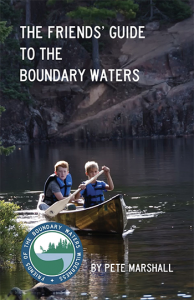
• Disclaimer and Use Policy
https://tigaprediksi.com/
https://armynavysuperstores.com/
https://dutawarta.com/
https://woaynews.com/
https://pupwb.org/
https://haraznews.com/
https://toysmatrix.com/wp-includes/slot-gacor/
https://girimenangnews.com/
https://geprekbensuindonesia.com/
https://everythinginclick.com/wp-content/uploads/slot-bonus/
https://caraslot.com/wp-includes/slot-bonus/
https://www.casablancahire.com/blogs/wp-includes/slot-bonus/
https://www.genesiscalbeautystudio.com/wp-includes/slot-bonus /
https://www.hookdonthehudson.com/
https://bimbelruangprestasi.com/wp-includes/slot-bonus/
https://thenews100.com/
https://expertautokool.ee/wp-includes/slot-bonus/
https://www.padslakecounty.org/wp-content/uploads/rekomendasi-situs-slot-gacor-gampang-menang/

Compare items
- Total ( 0 )
2-FOR-1 GA TICKETS WITH OUTSIDE+
Don’t miss Thundercat, Fleet Foxes, and more at the Outside Festival.
GET TICKETS
BEST WEEK EVER
Try out unlimited access with 7 days of Outside+ for free.
Start Your Free Trial

What are the Best Meals for a Multi-Day Canoe Trip?

Heading out the door? Read this article on the Outside app available now on iOS devices for members! >","name":"in-content-cta","type":"link"}}'>Download the app .
How light do you want to go? Unlike backpacking, which values economy above all else, multi-day canoe trips can bear more weight depending on the length of the journey and how badly you want filet mignon that first night. I go to the Boundary Waters each May with friends and we really, really want those steaks, which start the day hard as hockey pucks but are perfectly thawed by the time we reach our site (our other food splurge is five pounds of gummy worms, but I’d rather not talk about that).
Our meal plan for the rest of the week is significantly lighter, both in weight and calories, and involves a bit of calculated risk. We bank on catching fish for at least one dinner, a strategy that frequently pays off in the form of our signature BWCA meal: Triscuits topped with pan-fried lake trout and Gouda—a bite so delicious that all you can do is giggle like a child while eating it. Other times, our hubris angers the fish gods and we’re stuck eating granola bars at night.
If you want to go lighter (but more involved), follow the lead of Daniel Klein—a former cook at big-deal restaurants such as The Fat Duck and Bouchon and the creator of the James Beard Award-winning Web series The Perennial Plate , which looks at sustainable food practices around the world. I met Klein a few years ago and was struck by his simple, flavor-focused approach to eating in the BWCA. He starts by packing a few staples: salt, butter, a little cooking oil, dried fruit and mushrooms, wild rice, a couple spice mixes. And though he brings an emergency supply of dried food, he prefers to fish and forage for his supper, aided by an old spinning rod and his trusty Samuel Thayer field guides .
In the spring, he pairs wild ramps and morels with his bass, in late summer wild chanterelles and lotus root. Klein’s philosophy: Put a little effort into your meals and you can ditch that terrible dried soup for good (or at least until you’re skunked on the lake or in the woods).
Or just crowd-source your menu. BWCA.com’s messageboard is the finest spot online for all things Boundary Waters-related. The camping recipes forum is filled with discussions ranging from whether or not you can pan-fry chocolate chip cookies (you can and should), to DIY food dehydration tips.
- Water Activities
Popular on Outside Online

Enjoy coverage of racing, history, food, culture, travel, and tech with access to unlimited digital content from Outside Network's iconic brands.
Healthy Living
- Clean Eating
- Vegetarian Times
- Yoga Journal
- Fly Fishing Film Tour
- National Park Trips
- Warren Miller
- Fastest Known Time
- Trail Runner
- Women's Running
- Bicycle Retailer & Industry News
- FinisherPix
- Outside Events Cycling Series
- Outside Shop
© 2024 Outside Interactive, Inc
Sign up to receive tripping tips, promotions, and news!
Translation missing: en.general.currency.dropdown_label
- Create account

Canoe Trip Cooking 101
Posted by Bill Ostrom · July 17, 2023

Bill and I have been tripping for decades. We each started out with our parents in the 70’s with short weekend canoe trips, lots of fresh food (hot dogs!), cans (corned beef hash!), no portages. By the time we met up in university our goals had shifted to longer trips and wanting to get away from the crowds a bit more. Adding some portages, going out for longer, going into less travelled wilderness. So beautiful! So peaceful!
As our skills grew we assessed our gear and our food for weight and compactness. There is nothing better than finding that sweet spot of what you’re comfortable carrying on the portage and eating healthy, yummy meals.
We find that we can pretty much eat what we enjoy at home with some adjustments for weight and cooking outside. So read on for tips and tricks around menu planning, organizing the food, and cooking in camp. I’m sure there’s something in here for everyone!
Eating healthy food and balanced meals on a canoe trip ensures you’ve got good mental and physical energy for the day. It is especially important for kids … and parents.
Some people can live on protein bars, but there is something to be said for how food and cooking connects people on any outdoor adventure trip. Whether it’s teaching your kids how to light a fire, or enjoying cocktails during food prep.
Your menu, and how much you want to fuss over your evening meal is totally up to you.Our foodie friends go the extra mile in their camp cuisine. (And we love it!) But we’re more inclined to keep things simple so we can spend more time fishing or painting. Especially if it’s just the two of us.
Planning for Campsite Cuisine
As expected, the start of great campsite cuisine is in the planning. Obviously, it ensures you have enough food, but it also helps make sure that everything fits in your barrel or pack and mealtimes run smoothly. (Especially important with kids.)
Having said that, I think the most important benefit of good planning is that you come back with nothing but your emergency meal. That is the perfect indication that you’ve found that sweet spot between energy, good food and weight.
To that end, consider these questions when putting together your menu:
Are there any campsite regulations or restrictions?
Can and bottle bans are common in wilderness parks
Fire bans - Oh my goodness! As I write this (June 2023) I think parks, crown land and BLM lands in Ontario, Quebec, Alberta and Northern Minnesota are all on a fire ban. And the summer of 2022 was bad as well.
How many hours paddling each day? How much portaging?
The answer to these questions will determine how much fresh food to bring (weight factor.) How many desserts! (more weight) How much prep is needed in camp (time factor.) And whether [pancakes!] a cooked breakfast every day makes sense (more time.)
If you’re heading out for more than 2 weeks, it might make sense to adopt more of a pantry-style approach to menu planning where you bring ingredients and supplies to cook certain meals.
Who’s coming?
Are you solo? Just you and a buddy? Small group? Big group?
If you’re paddling with a group you can decide who’s responsible for what. If we paddle in a small group we tend to bring our own breakfasts and lunches and then split up the dinners. It often makes sense to plan communal breakfasts and lunches with a larger group.
Any food allergies or sensitivities?
I’m surprised my friends still invite me on canoe trips. I’m allergic to this…I don’t like that…However, my dietary needs are easily accommodated by my bringing my special cheese, or granola (porridge makes me gag.) Or taking out my portion from the pot before mixing in ingredients I can’t eat. While it may sound complicated, it’s easy to plan for at the time of menu planning. And people like me really appreciate the accommodation.
Canoe Tripping with kids?
This is the time to get your kids involved. Research fun canoe tripping foods. Ask them what they want to eat. And plan on a menu of foods that they love to eat.

Canoe Trip Menu Planning Tips
Once you know how much weight you’re willing to carry, and how much time you’re going to spend in the morning and with supper prep, you can put together a menu. You can make decisions on fresh vs dehydrated foods, and quick and easy vs more complex meals. (Keep reading for tasty recipes.)
Make a chart with each day and each meal plus snacks. Handwriting is more fun. But typing up a template makes it easy for next time.
Don’t forget the coffee!! Our niece ended up with a 3 day migraine (with 4 kids) when she forgot the coffee (that only happened once…) Bill’s go-to breakfast is peameal bacon and english muffins. Mine is granola. My friends love porridge with dried fruit. We bring loaves made ahead of time if there’s room. I know people that scramble up eggs in a watertight container for their first breakfast. (Powdered eggs are also really good!)

Our lunches tend to be quick and easy since we’re often paddling or portaging. A mix of pitas, wraps, bagels, croissants, pepperettes, kielbasa, cucumber, and fresh hummus for the first few days. Then a transition to cheese, crackers, peanut butter, dehydrated hummus or black bean dip later on. This is where it’s so fun with a large group because you can literally lay out a smorgasbord so people can eat what they love, from peanut butter to stinky cheese!

We often plan the first 3 days of fresh meat and veggies for suppers - Marinated chicken, then steak, and then a processed meat like sausages or ham. Veggies, potatoes, and bread work as fresh side dishes. Our vegetarian friends plan on meals like portobello mushrooms, avocados, beans and lentils. Then dehydrated meals after that.
If you’re going to fish, be sure to bring whatever you need to cook them up. We love a good fish fry and always have enough oil.
It’s all about the GORP (Good Ol’ Raisins & Peanuts - aka Trail Mix)! For kids, and me too, there is nothing more fun than going to the bulk food store and choosing snacks for your GORP. Granola bars, protein bars and fruit bars/fruit leather are also amazing. Bill always has a Mars bar handy. Make sure you’ve got something that can give you a burst of energy if you need it on the water or the portage.
Hot Beverages

There’s no reason you can’t keep your hot drink routine on a canoe camping trip. Hot coffee in the morning, herbal tea after supper, etc. Your kids may not have a routine at home, so be sure to plan something hot and yummy at breakfast and perhaps after supper. It helps with hydration. As well, bringing cup-a-soup or powdered soup mix for quick warmth on a rainy day makes everyone feel better. It’s also great for an end of day salty rehydrating appetizer.
Cold Beverages
Don’t forget whatever you need to purify your water (water filter, tablets, UV-stick.) Waterborne illness is not fun. Then bring whatever you need to make sure you and your kids “love” drinking water so you stay rehydrated. If the weather is hot, and you’re working steady, then it also makes sense to bring powdered electrolytes, especially if you’re prone to cramping.
Fresh fruit and vegetables
This can be a constant debate between those who love a little “crunch” at lunch and supper, and those who don’t want the weight (or bulk) of carrying an apple a day to keep the doctor away. In reality, dried fruit and vegetables are just as nutritious. Having said that…we often bring a small cabbage and shred it up with a homemade oil and vinegar dressing. Fabulous on days 4, 6 and 8! As well, it’s ok to bring 1 apple for 4 people just to get that burst of juiciness. Again - the length of your trip and portages will help you decide.
Think about your meals and bring the spices you need.
Although I have friends that would say martinis are a much more efficient use of space and weight. Cocktails are just as amazing while camping as they are at home. If you can make the room and the weight…why not.
If you want to go light and fast…deserts will weigh you down. However, there is something to be said about loading up on carbs for the next day. Even on easy trips, we’re still moving much more than in town. Camp deserts can be as easy as S’mores or brownies from home.
My friend brings fresh bananas for Banana Boats for that first night. There is nothing yummier than bananas and chocolate chips wrapped in tin foil and baked on the fire.
Grocery List
There is nothing worse than being in the throes of packing food and realizing you don’t have something. Systematically go through your menu and make a list, including quantities of each food item.
This is how I organize our shopping list(s).
- Food that needs to be dehydrated (because I need to buy this well in advance)
- Fresh food, meat, bread/wraps/pita (which gets bought a day or two before so it can go in the fridge or freezer.)
- Other non-perishable foods that can be bought anytime.
- Dehydrated meals or foods from an outdoor store. (done well in advance if ordering online)
- Bulk food store (done at the last minute so I don’t eat all my gorp before the trip!)
The goal of packing your food up is to reduce the time rummaging around in the food barrel or food pack for the next meal…or the sugar for your coffee! There are at least 2 schools of thought.
The first is to organize by day. So 1 bag or stuff sac per day with smaller bags for breakfast, snacks, lunch, supper, and dessert. Our friend does this for her family and it helps ensure variety and minimizes fussing around.
The second way is to organize by meal, and then have the menu handy. It looks like this.
Each supper is in its own mesh bag or stuff sack. On longer trips, suppers for later on are just thrown in the bottom of the barrel. Earlier suppers are together in a bag closer to the top. This maximizes space.
Lunch foods are in a bag, and the day’s lunch is always at the top of the barrel for easy access.
Breakfasts are in a bag. And hot drinks are in a separate bag for easy access anytime during the day. Afternoon coffee anyone?
Snacks are in a bag and everyone can take what they need for the day. For bear safety, don’t forget to put all snacks back in the food barrel or food pack for the night.
The second goal is to not forget anything. Consider an itemized list for each ingredient in each meal. Here’s a photo of how I keep track of our suppers, and the list keeps going for breakfast, lunch, hot drinks and pantry items.

We’ve already talked about breakfast and lunch ideas. Here is our famous “Pineapple Beef Stir Fry” recipe. Followed by a delicious fry pan quesadilla.
🍍 Pineapple Beef Stir Fry 🍍
(Quantities will depend on the group you’re feeding.)
Beef Jerky – any soy sauce-based marinade with garlic and/or ginger
Pineapple chunks
Brown Sugar
Corn Starch
Oil for frying
- Rehydrate the beef, veggies and pineapple by putting in a pot with just enough water to cover – bring to boil, remove from heat, and let sit for about an hour while you set up your tent.
- Drain the water into a bowl. Make the sauce by adding soy sauce, and brown sugar to taste.
- Fry up the rehydrated ingredients, sprinkling with the garlic and ginger. (Smells so good!)
- Add the sauce.
- Mix up cornstarch in cold water and add to the pot. Do a taste test and add more spices, soy sauce or sugar. Bring to a boil and stir til it thickens.
- Serve over rice vermicelli noodles or rice.
Pizza Quesadillas
This is a great meal for kids and picky eaters...because everyone makes their own. Decide what you’re going to have “on your pizza” and dehydrate those ahead of time or bring fresh. Think pizza sauce, cheese, pepperoni, peppers, mushrooms, olives, onions, pineapple.
As you can see, the base is a flour tortilla (and our gluten-free friend has found coconut tortillas). Simply load up ½. Fold over the tortilla. Cook one side on low to medium heat and flip when browned. A lid helps but is not necessary. Enjoy!
If you want to freshen up your menu and learn about dehydrating meals, then check out Kevin Ride’s Backcountry Eats book and youtube channel. He is a wealth of information for newbies and seasoned canoe trippers alike.
It is super easy to plan flavourful, nutritious meals on canoe trips that fill the belly and feed the soul. Take the time to plan ahead and adjust the menu to your people and your route.
Definitely take the time to make lists - first the grocery list - then the packing list - so you don’t forget the coffee!!!
Happy paddling
Anne & Bill

Canoe Trip Pack List: 62 Essentials for Backcountry Camping
Are you planning a backcountry camping trip in North America this summer?
I have been on several canoe trips in Algonquin Park and know how overwhelming it can be to pack for a multi-day camping adventure.
Forgetting a single essential item can make your trip less enjoyable or even put your safety at risk. That is why I have compiled a comprehensive list of 65 essential items for your canoe trip pack list .

I have learnt these tips from my numerous camping trips to Algonquin Park in Ontario , plus with the help of experienced campers who have been canoe camping for over 15 years. You can trust that this list covers everything you need on your canoe camping checklist.
Whether you are a seasoned camper or a first-timer, this article is perfect for anyone planning an overnight canoe camping adventure in North America this summer.

Want to receive this canoe camping packing list as a printable or fillable checklist ?
Canoeing Trip Packing List
- Sleeping and Shelter
- Food and Water
- Safety and Navigation
- Personal Items
This portaging packing list is organised into categories.

Use the information in the categories above to learn about packing for a canoe trip in the backcountry.
Backcountry camping is a type of camping in which you have no access to running water, a toilet, mobile service, or electricity .
The main difference between backcountry camping and car camping is that you must carry all your belongings to the backcountry, either by foot or canoe.
Therefore, for backcountry canoeing, you need to pack as light as possible so it is possible to carry it.
You do not have to consider the weight and number of objects as much with car camping .
Sleeping & Shelter: Most Important Packing List Items
Some of the most important things on your packing list for canoe trips are items you will use for shelter and sleeping.
These overnight camping essentials may seem like luxury items, such as a sleeping mat or a pillow – but they will improve your sleep quality immensely.

Selecting the right tent is crucial to ensure a comfortable and safe canoe camping experience.
For extra comfort, bring a tent that can accommodate one more person than your group , as this allows for extra space for moving around and using the tent for changing or resting.
When looking for a tent, consider its durability and waterproof features to protect against weather conditions like rain and wind.
Additionally, the weight of the tent should be considered since it can be challenging to pack and carry a heavy tent on a canoe trip.
If you need more tips on choosing a tent, check out this tent guide on the REI website .
The tent we use is the MSR Hubba Bubba 3-Person Tent .
- Best Budget : NEMO Aurora Tent
- Best Luxury : MSR Hubba Bubba Tent
2. Trekking Backpack

Your canoe trip may involve hikes and portages to get to your campsite . Therefore, you need to bring a large bag that you can fill with essential canoe trip items , such as sleeping bags, a tent, equipment, and emergency items.
Ideally, you want a large rucksack that has padded shoulder straps for comfort.
Many portages, such as those around Lake Magnetawan , involve hiking for over 1km – which will take much longer than a regular 1 km hike, given you will be carrying heavy equipment.
You also need a waist strap on the bag to support your back and balance the weight of the bag.
If you purchase a high-quality trekking rucksack it will last many years. For example, we use these Gregory backpacks and they are around 10 years old.
- Best Backpack : Gregory Stout 60L Backpack ( men’s product available here )
3. Sleeping Mat

Depending on your budget, you can use a regular sleeping pad, which is like a yoga mat, or bring a self-inflating sleeping mat .
The latter will likely be more expensive but will protect your back more from feeling the rocky terrain.
Consider that if you are a side sleeper, you may need to find more specialist products because even with an inflatable sleeping mat, you will feel discomfort on your side.
The sleeping mat we use is Therm-a-Rest Prolite . It is self-inflating and easy to roll-up.
- Best Budget : Stoic Groundwork Sleeping Pad
- Best Luxury : Therm-a-Rest Prolite Sleeping Pad
4. Sleeping Bag
Another of the most crucial items on your overnight camping packing list is the sleeping bag.
There are several types of sleeping bag. You can choose a sleeping bag based on its features, such as its lowest suitable outdoor temperature and whether it is fit for males or females.
Take some time and research to discover which sleeping bag will work best for you.
For those based in Canada , MEC has an excellent selection of sleeping bags (our sleeping bags are from MEC).
- Best 3-Season Sleeping Bag : NEMO Disco 30 Sleeping Bag ( men’s product available too )
5. Camping Pillow

If you do not bring a pillow, you will soon see why a camping pillow is a necessity . Sleeping on a rolled-up piece of clothing will not be as comfortable as a blow-up pillow.
Camping pillows are packable, and many of them are inflatable, so you can adjust the firmness of the pillow.
The pillow we use while camping is NEMO Fillo Backpacking Pillow . You can adjust the firmness of the pillow using the inflation valve.
- Option 1 : NEMO Fillo Backpacking Pillow
- Option 2 : Sea to Summit Aeros Ultralight Inflatable Camping Pillow
Bring a long, strong rope to hang your food barrel from a tree branch.
Pack another rope to hang tarps or make clothing lines .

A tarp is an excellent item to add to your canoe trip gear list because it packs up small and can be valuable in case of rainfall .
You can set up additional space for daytime use or use the tarp to keep other items dry at night if there is no space inside your tent.
Therefore, make sure you purchase a heavy duty tarp that is fully waterproof.
You can various options for tarpaulin on Amazon or other camping equipment stores.
- Best Budget : Amazon Basics Waterproof Camping Tarp
- Best Luxury : Sea to Summit Escapist Tarp (Medium)
Food and Water: How to Prepare for a Canoe Trip

In this section of the canoe trip equipment list, you will find all the gear you need to help with eating and drinking while on a canoe camping trip .
You should pack enough food for the entire duration of your trip.
If your backcountry camping trip exceeds three days , you should bring dehydrated or freeze-dried food ; otherwise, the fresh food you took may not stay fresh.
Large water containers are heavy to carry in addition to your other canoe expedition gear.
So, aside from the water you already have in your water bottle, you will need to use other water sources for drinking and brushing your teeth.
Nonetheless, you cannot drink directly from most lakes due to the risk of giardia (beaver fever). The bacteria from the water can cause some severe side effects. You need to make sure you purify any lake water before drinking it.
Some destinations, such as deserts, do not recommend attempting to purify and drink their water because it can clog filters. Therefore, you will need to bring large containers of water. Remember to bring enough water for drinking, cooking, and brushing your teeth.
8. Water Filtration System

A gravity bag is an excellent way of filtering lake water and making it potable. Water is abundant while canoeing; therefore, gravity bags are a great option to use to make drinking water.
A gravity bag is more expensive than other water purification methods, but consider it an investment because you can use it for many camping trips to come.
This is the water gravity bag we use on our backcountry camping trips.
- Best Budget : Katadyn BeFree 3.0L Water Filter
- Best Luxury : Platypus GravityWorks 4.0L Filter System
9. Water Purification Tablets
These tablets are a compact and low-cost way (in the short-term) of purifying your water so it is safe to drink. However, purifying tablets can make the water taste a little different to normal, so you may prefer to use another water filter method.
It is advised to bring some water purification treatment tablets as a backup in case your gravity bag water supply fails. In this case, you will still have a method of drinking clean water.
- Aquatabs 49mg Water Purification Tablets
10. Camp Stove

Another significant item to add to your canoe trip pack list is the camping stove. This piece of gear is essential to your survival while camping, particularly if you have no access to a fire pit for cooking.
Once you have bought a stove, you should also guarantee you know how to use it.
If you have not used your camp stove since your last camping adventure, check it is working before you embark on your next canoe trip.
- Best Budget : MSR Pocket Rocket 2 Stove
- Best Luxury : Jetboil MiniMo Camping and Backpacking Stove
11. Kitchen Cookware

A good set of cookware, including knives, forks, spoons, plates, a saucepan, and a frying pan, will make meal preparation and serving a smoother experience in the backcountry.
Instead of bringing so much cutlery, you could also purchase a spork – a cross between a fork and spoon.
It is beneficial to have a cookware set that packs up inside itself.
If you are purchasing an MSR stove, there are often bundles that include some cookware.
- Stove and Cookware Bundle : including Sauce Pan, Deep Dish Bowls, two Insulated Mugs, Strainer Lid, and two Folding Sporks.
- Jetboil Frying Pan
- MSR Kitchen Utensil Set – includes Folding Spoon, Spatula, Ultralight Cutting Board, Salt & Pepper Shaker, Squeeze Bottle and Dish Towel.
In addition to knives used for eating, you need a sharper knife to cut food such as fruit or vegetables.
13. Bear-Proof Food Containers

A food barrel will keep your food safe from bears and the elements while you are on the water or in the backcountry.
It is also a great way to organise your food and keep everything in one place. You can also use it to store other scented toiletries.
When packing your food barrel at home, review the order you pack your food, with the items you will need first at the top.
A food barrel is heavy and difficult to carry when full. It is recommended to attach straps to carry the barrel like a backpack to make portages easier and allow your hands to be free to carry other objects, such as paddles.
- Food Barrel (MEC Canada)
- Straps for Food Barrel
It is also possible to purchase bear-proof bags and bear resistant food containers . These can fit inside your other backpacks and will keep your toiletries and food safe.
14. Water Bottle
Staying hydrated is essential when canoeing and camping. Bring a reusable water bottle to refill as needed along the way.
Even though insulated water bottles are good for keeping your beverage cold, I suggest bringing a lightweight plastic bottle. Plus, you will want a wide-mouth water bottle in which you can easily place an electrolyte tablet .
15. Empty Plastic Bag
Be sure to pack out everything you bring in. An empty plastic bag for waste will help you keep your campsite and the surrounding wilderness clean.
Remove packaging from new items before you leave for camping so you do not have unnecessary trash on you.
16. Espresso Maker
If you cannot go a day without coffee, you can bring a small espresso maker. It may be challenging to bring milk, so you need to drink it black.
17. Lighter
Starting a fire is essential for cooking and staying warm. Be sure to bring a lighter, as well as a backup option, such as additional lighters or waterproof matches .
18. Collapsible Sink

When backcountry camping, a collapsible sink is a useful to wash your dishes.
Washing dishes near your campsite or water source can contaminate the environment and attract wildlife. Therefore, a packable kitchen sink is handy to contain your dishwater and move it somewhere safe for disposal.
Collapsible sinks are lightweight, easy to pack, and a great item to add to your wild camping kit list.
- Best Budget : Flat Pack Sink
- Best Camping Dish Wash Station : Sea to Summit Collapsable Wash Bag
Safety Items: Canoe Camping Gear List

Some items on this canoeing equipment list are for an emergency; therefore, you hope that you will not have to use them.
Whereas, other canoe camping gear is essential; such as flashlights, a hatchet to cut wood, and a map to keep on the right path.
As well as possessing these items, you need to be up to date on your bear safety.
Many destinations across North America, such as Banff and Algonquin Park are home to bears.
You can read about being “ bear wise ” here.
Rent canoes if you do not have one. It is a major piece on a canoe gear list.
Once you have determined where you will be backcountry camping, you should investigate canoe rentals.
If you will be camping in Algonquin Park, I have given recommendations for canoe rentals for Rock Lake Access Point and Magnetawan Lake Access Point .
20. Paddles
Just as with canoes, you must bring or rent paddles to steer and propel your canoe.
Each person needs a paddle.
21. Personal Flotation Device
Many parks require you to wear personal flotation devices, also known as PFDs, or at least have them in your possession. A lifejacket can save your life in case of an emergency.
Canoe and paddle rental companies will give you lifejackets to wear for your canoe camping trip.
22. First Aid Kit

Accidents can happen, and having a first aid kit can help you take care of minor injuries, such as blisters and cuts.
Consider the number of people on your camping trip and how many days you will be camping for. As you can see in the adjacent image – the medical kit we took was enough for two people on a two day trip.
Check you also have painkillers and anti-inflammatory drugs in your first aid kit.
If you use anything from your medical kit while backcountry camping, make sure you replace it for the next trip.
- Adventure Medical Kit
Even if you visit your place of backcountry camping often, you should bring a map so that any group member can use it if needed.
Have it in a waterproof case so it will not be ruined by rain or dropped in a river.
When the sun goes down, it gets incredibly dark in the backcountry when all you have is the moonlight. You will need a reliable light to navigate in the dark and find your way around camp.
A flashlight or headlamp is useful for walking around the campsite in the evening.
A lantern is good for putting around the camp or inside your tent when winding down for the evening.
25. Hatchet and/or Sledgehammer
These tools will come in handy for preparing firewood. Plus, a sledgehammer can be used to hammer tent pegs if the ground is hard.
26. Compass
A compass can help you navigate and stay on course when you have no service.
27. Firewood
Verify whether there is a fire ban in the park before you enter.
You may not even need firewood if you have brought your camping stove. Although, if the weather is good, you can rely on wood that you gather on your camping site for cooking.
If there is no fire ban, buy wood from the park office. You cannot bring wood from outside the park.
Clothing for a Overnight Canoe Trip Packing List

When deciding what to wear on a canoe trip, bring the fewest number of clothes possible .
For shorter trips, less than three nights, you can typically get away with the daytime clothes on your back, plus an extra set in your pack.
After a few days of no access to showers on overnight canoe trips, you will embrace wearing the same clothes.
Although, you may wish to leave an extra outfit in the car for the end of the trip to travel home without smelling like a bonfire or sweat.
Keep an eye on the weather forecast in the days approaching your canoe trip. The weather can change quickly, but the forecast should indicate if you will face cold or hot temperatures or rainy conditions.
The best kinds of fabrics for backcountry camping in summer are lightweight and quick drying ; for example, exercise shirts from Lululemon or swimming trunks for men.
However, do not bring any of your best clothing that you would not like to get damaged or stained in case of any accidents or that is not easily replaceable if needed.
Read on to find all the items of clothing that should be on your backcountry camping overnight checklist.
28. Dry Bags

Before you pack any clothes on your canoe camping list, you need a waterproof bag to put them in.
Dry bags are the best for storing items that need to stay clean and dry. They are waterproof and the top folds over to stop any water from entering if the bag falls out of your canoe or kayak.
SealLine is a reputable brand of dry bags.
You need dry bags in varying sizes, for example smaller ones for your clothing , and a larger one (with straps) for sleeping bags .
- Best Large Dry Bag: 65L SealLine Dry Pack with Straps
- Best Small Dry Bag: 10L SealLine Dry Bag
29. T-Shirts
Ideally, you will bring short-sleeve t-shirts in a sweat-resistant fabric .
Full-sized t-shirts are best for canoeing because they will cover your shoulders , which can burn on a sunny day. Plus, the material will make you feel fresher for longer.
Some suggested brands for this kind of t-shirt include: Lululemon and Adidas.
- Ladies ‘ Crew T-Shirt from Lululemon
- Ladies ‘ Running T-Shirt from Adidas
- Men’s Drysense Short Sleeve Shirt from Lululemon
Shorts are typically the best clothing to wear as bottoms for canoeing. It can get warm and sweaty on summer canoe trips.
Plus, it is common to splash water on your legs when paddling, so it will dry quicker on your bare legs and shorts than on trousers.
Quick-drying shorts are better than cotton shorts.
- Ladies ‘ Mid-Rise Lined Shorts from Lululemon
- Men’s Baggies Shorts from Patagonia
31. Warm Sweater
Even though you are going on an overnight canoeing trip in summer, it can still get cold at times. You will likely need to wear a sweater, or another long-sleeved layer, such as a fleece, to keep warm once the sun has set .
Additionally, covering your arms in the evenings will help prevent mosquito bites .
It is best not to wear the same clothes to sleep in that you have cooked or eaten in (in case of any smells or remnants of food left on the materials) at night due to bears.
Therefore, ensure you have a warm enough sleeping bag or another long sleeve layer to wear for sleeping if you get cold easily.
- Gender-Free Crew Sweatshirt from Roots Canada ( available on US website here )
32. Long Pants

Another item of clothing that is good for canoeing trips is a pair of trousers, that are not jeans. This type of long pants is handy for evenings, when the temperature is cooler, and the mosquitos are out.
Leggings are typically too thin to stop mosquitos from biting through the material, so they are not the best trousers to wear in the evening on camping trips.
Sweatpants or other exercise trousers, such as these Lululemon trousers are better options for camping .
- Ladies ‘ Stretch High-Rise Pants from Lululemon
- Men’s Training Joggers from Lululemon
33. Leggings or Long Johns
It is recommended to bring leggings or other thermal pants because they are good for sleeping . If you think you may get cold legs at night, it is best to pack a pair of leggings.
I usually start by wearing leggings as it is cold at the start and middle of the night. By morning, you may want to wear shorts.
The best quality leggings for ladies, in my opinion, are from Lululemon .
- Ladies ‘ Align Leggings from Lululemon
- Men’s Thermal Leggings from Icebreaker
34. Bathing Suit
You will need some swimwear on your backcountry camping trip for several reasons. Firstly, after a long, hot portage, a refreshing dip in the lake may be just what you need. Secondly, swimming may be the only way to wash yourself during your camping expedition.
Ladies, bring a two-piece if possible because it will dry quicker and it will make going to the bathroom easier if you are exploring while wearing your bikini.
35. Daytime Socks

It is important to bring enough socks for each day to wear during the daytime because you might find your socks will get damp and sweaty.
You may prefer to wear active-wear socks as these will cope better with the dampness of the foot from hiking and paddling.
Also, check that your socks cover your whole heel to avoid getting blisters .
It is best to wear socks that come just above the ankle because it will help protect them against potential scrapes while hiking .
- Ladies ‘ Hiking Socks from Lululemon ( socks available for men here )
36. Warm Socks
I recommend bringing some thicker socks that you can wear in the evenings to cover your ankles from mosquitoes. Plus they are good to keep your feet warm at night .
Roots is my favourite shop to buy these types of socks from.
- Cabin Socks – 2 Pack
- Cabin Ankle Socks – 2 Pack
37. Underwear
This is self-explanatory, but bring enough underwear for the entire duration of your trip.
Men – you may be fine with wearing swimming trunks while canoe camping. But think about nighttime and other times you will not be wearing swimwear.
Ladies – sports bras are better than regular bras because they will hold up well to sweat. You can wear bikini tops the whole time, but you may want better support while carrying the canoe/equipment on portages or paddling.
38. Rain Jacket
You should bring some rain gear, even if it does not look like rain is in the forecast during your canoe trip.
Rain jackets are usually easy to roll up small into a bag. Plus, you can use your raincoat as an extra layer if it gets cooler.
- Best Luxury : Arcteryx Beta Rain Jacket ( Beta LT for Women ) ( Beta Lightweight for Men )
- Best Budget : North Face Rain Jacket ( Antora Jacket for Women ) ( Antora Jacket for Men )
Wide-brimmed hats are great for canoe camping because they cover more of the face and neck than baseball caps. However, a baseball cap will also work if that is what you already own.
If you already own a wide-brim hat from a safari or other similar trip, bring it.
Check the night-time temperature because it is chillier at night. If so, you may want to bring items such as a knitted hat or gloves – but this is more for spring and fall trips .
- Women’s Wide Brim Bucket Hat from Lululemon
- Sinsola Sun Hat from Arcteryx
- Abisko Sun Hat from Fjallraven
- Roots Baseball Cap from Roots
40. Sunglasses
Sunglasses will be another one of your canoe trip essentials. Do not bring your favourite pair of sunglasses in case they get lost or broken. However, make sure that the sunglasses you bring have sufficient UV protection .
You may benefit from having a string/rope to secure them around your neck when you are not wearing them.
- Sunglasses Strap
41. Old Running Shoes or Hiking Shoes
The best canoe trip shoes are durable and comfortable, but also you should be fine with them getting a little wet.
There are occasions while camping that you may accidentally step in water when getting in and out of the canoe. Therefore, you should be fine with wearing the shoes in water , or they should be able to withstand the wetness.
I suggest bringing an old pair of running shoes or sturdy hiking shoes.
I wore my Blundstone Boots when camping but I got bad blisters from the rigorous portages, so I would not recommend wearing these if you are prone to blisters.
- Women’s Hiking Shoes from Merrell ( Men’s version available here )
42. Campsite Shoes
You will need shoes to wear around your campsite, such as sandals. Campsite shoes give your feet a rest and a breath from the trainers you wear during the day.
I would avoid bringing flip-flops because it is tough to wear these with socks on, which you may want to do in the evenings.
A solid pair of sandals, such as Tevas are beneficial because they also can be used for walking and canoeing.
- Teva Sandals for Women ( Men’s version available here )
- Keen Sandals for Women ( Men’s version available here )
Toiletries: What to Pack for Backcountry Canoeing
43. biodegradable soap.

It is essential to bring biodegradable soap because it will decompose more quickly in the wild than conventional soaps.
Read about other best practices for camping and how to respect the environment, follow the Leave No Trace principles .
You will use soap to wash your dishes and to wash your body. It is one of the biggest must haves for tent camping.
- Best Budget : Campsuds Biodegradable Soap
- Best Luxury : Dr Bronner’s Pure-Castile Liquid Soap
44. Toothbrush and Toothpaste
Keeping your teeth clean while camping will help you feel fresher while away from many basic amenities. It is recommended to bring a manual toothbrush rather than an electric toothbrush.
Plus, those small travel tubes of toothpaste are handy to keep your toiletries as light as possible.
45. Sunscreen
Protecting your skin from harmful UV rays is especially when canoe camping because you may spend much of the day in direct sunlight. Facial sun cream should contain SPF 50 .
Spray sunscreens are good for the rest of the body because they can be applied while on the go. You may get sweaty while portaging or canoeing, so choose the thicker sports suntan lotions so it stays on for longer.
Here are my favourite brands of facial sunscreen:
- La Roche Posay Face Sunscreen
- Cetaphil Face Sun Protection
46. Deodorant
Do not forget basic hygiene while camping. Unscented deodorant is best to avoid attracting insects.
47. Antihistamine
If you are prone to mosquito bites, antihistamines will help relieve symptoms caused by bites, stings, or other allergens.
48. Bug Spray
Mosquitoes and other insects can be a nuisance in the backcountry, particularly while in wooded portages. You will need to apply insect repellent liberally to keep them at bay.
- OFF! Deep Woods Insect Repellent
49. Medication
Be sure to bring any necessary medication for your personal needs, such as prescription medication.
50. Antiseptic Cream
For minor cuts and scrapes, antibiotic ointment can help prevent infection. Polysporin and Neosporin are commonly found in North America.
51. Toilet Paper
Bring several rolls of toilet paper. You can buy toilet roll for camping that is designed to be biodegradable and environmentally friendly.
52. Tissues
Tissues are always handy for various uses. You can bring a small travel pack.
You will need to take your used tissues home with you.
53. Hairband
If you have long hair, it is a good idea to bring a couple of hair ties to keep your hair out of your face during physical exercise.
54. Hairbrush
You will likely wear a hat for the entire camping trip, but you should bring a compact brush or comb to keep your hair tangle-free.
Bring a microfibre towel to dry off after swimming or bathing. Microfibre towels are quick-drying, lightweight, and easy to pack up small.
Personal Items for Camping
The following items are non-essential when packing for a canoe camping trip, but you may find them useful.
56. Portable Power Bank
If you plan on taking photos on your phone while backcountry camping, you will need to bring a portable phone charger . The iPhone will only last a day or two, even when set to Airplane Mode.
57. GoPro Camera
Another option for taking photos or videos while on a canoe trip is using a GoPro . This type of camera will last longer than using a phone.
You can bring any camera that has three days’ worth of battery.
58. Mosquito Net Hat

If you are susceptible to mosquito bites, you may find it useful to bring a mosquito net hat . This will be useful during the evenings when the mosquitos come out in full force.
Some portages can be extremely buggy, so a mosquito net hat can bring some relief.
Mosquito net hats are also extremely useful for visiting places like Scotland in summer .
59. Belt Bag
Ladies and gentlemen, you may want to bring a fanny pack for any small canoe camping essentials to always keep on you, for example, lip balm, tissue, camera/phone, and allergy tablets.
Everyone is a big fan of the Lululemon belt bag , me included, but you can also find other versions of belt bags on Amazon .
60. Backpack
If you plan to embark on day trips without your main camping gear, you should bring one backpack for the group. You can fill it with food for the day, a medical kit, sunscreen, and other essential items.
If you will be portaging each day to a new campsite, you will not need a daypack.
- Osprey Tempest Hiking Backpack 20L
61. Fishing Rod
If you are into fishing, you could bring some fishing equipment. However, ensure you have the proper authority to fish locally. Many parks require permits for fishing.
62. Camp Chair
If you still have space and can carry it, you could bring a camping chair. These are better for backcountry canoe trips where you stay at one campsite , so you do not have to carry it for as long.
- Best Luxury : Ultralight Compact Camping Chair
- Best Budget : Lightweight Folding Camping Chair
63. Secure Case
If you have brought expensive camera equipment or phones, you may prefer to keep them in a safe container while on the water.
Pelican cases are shock-proof and waterproof and will prevent anything from happening to your luxury items. Check you have the right size for your camera and other precious goods.
64. Playing Cards
Another idea for passing the time is to bring cards so you can play games with other campers.
You may have some downtown during the day or evening while camping, so you can bring a book to read. I suggest packing a paperback book rather than a hardback so that it is lighter to carry.
FAQ – Canoe Trip Pack List
What to wear canoeing.
If you are canoeing in a warm climate, you should wear shorts and a T-shirt covering your shoulders. Wear quick-drying materials such as nylon or polyester, and avoid cotton as it tends to get heavy and uncomfortable when wet. A hat and sunscreen are essential when canoeing.
If it is a little cooler, you could swap out your t-shirt for a long sleeve t-shirt or add a flannel shirt on top. You should have access to a raincoat in case of a turn in the weather conditions.
Canoeing: What should I take on a canoe trip?
Some of the most important items to bring on a canoe trip include, a life jacket, paddles, map and compass, first aid kit, insect repellent, sunscreen, and a water filtration system or enough drinking water. Other useful items include dry bags, camping gear, cooking supplies, and appropriate clothing and footwear.
What shoes do you wear for canoeing?
The best canoe portage shoes are hiking boots or walking shoes due to their support, traction, and waterproof features. It is also a good idea to pack sandals to wear around the campsite and they can be worn while canoeing too.
What should I pack for a 3 day canoe trip?
No matter the length of your canoe trip, you will need roughly the same amount of essential camping gear, such as a tent, sleeping bag, and toiletries. However, you may need to adjust your packing accounting for food and clothing.
Make a meal plan for your camping trip to consider all meals, including snacks, to ensure you do not forget any food. As for clothing on a 3-day canoeing trip, you should wear one set of camping clothes and pack another set. Make sure you bring enough socks and underwear for each day.
Samantha is the founder of Continuous Roamer, a travel website focusing on adventure and the outdoors.
With a love for adventure and the great outdoors, Samantha shares tips on skiing, luxury safaris, camping, and finding hidden food gems in different destinations.
With over 20 years of skiing experience across Europe, North America, and beyond, she's also an expert in luxury accommodations and experiences.
Whether camping in Canada or dining in a Michelin-starred restaurant, Samantha always seeks out the best experiences and accommodations, and her blog highlights the best of them for her readers.
Samantha is currently living in London.
Similar Posts

Complete Guide to Algonquin Portages & Backcountry Camping
As someone who has spent the past four summers embarking on numerous backcountry camping trips in Algonquin Park, I have…

Yurt Camping Tobermory: Everything You Need to Know For a Memorable Trip
Before I went yurt camping in Tobermory I tried to do some research online. Other than what Parks Canada, the…

Magnetawan Lake Access: How to Plan Your Backcountry Adventure
Ontario Canada has some of the best camping locations in North America because Ontario is home to the magnificent Algonquin…

Canoe Trip Meals 101: Discover the Best Canoe Camping Meals
Canoe camping, also known as backcountry camping, is an adventure where you travel by canoe to a remote destination to…

Rock Lake Algonquin: First-Time Backcountry Camping Guide
Rock Lake Algonquin Park in Ontario, Canada is a beautiful destination for backcountry camping in Ontario. It was the first…
- Secluded Lodging
Menu Planner
- For Full Outfitting-- select from the following menu your food for your entire trip. The cost is included in the Full Outfitted trip price.
- For Partial Outfitting Meal Plan-- select from the following menu your food for your entire trip. Meal Plan includes food and food pack/food cooler. Price of Meal Plan with a food pack is $35/day.
For breakfast and dinners on the first day of your canoe adventure, we recommend fresh and frozen foods. We provide a soft-sided cooler to keep this food fresh. After one day the menu switches to bulk and freeze-dried food, or if you prefer, we will provide bulk and freeze-dried foods for your entire trip thus cutting down on the extra weight of fresh and frozen foods. The choice is yours!
Fresh / Frozen Foods Meal Menu
Included with full outfitted and meal plan trips. Select the fresh breakfast and dinner you would like for the first day of your trip.
Bulk and Freeze-Dried Options
Included with full outfitted or meal plan trips (select meals for additional day after first day)
Food Staples and Extras
Included with full outfitted and food plan trips. Please let us know if there are anything on this list you will not be needing.
Additional Accessories
Included with full outfitted trips.
- Fishing Kayaks
- Paddle Boards
- Life Jackets (PFDs)
- Boat Storage
- Paddling Clothing
- Paddling Accessories
- Cool New Gear
- Submit a Review
- Paddling Near Me
- Paddling Locations Map
- Download the Go Paddling app
- Paddling Trips
- Kayaking Trips
- Canoeing Trips
- Share Your Knowledge
- Add a Paddling Location
- Add Your Trip
- All Articles
- Getting Started
- Boats & Gear
- Techniques & Safety
- Camping & Survival
- Join Newsletter
- Create Account
- Message Boards
- Classifieds
- Photo of the Week
- Free Weekly Newsletter
How to Plan a Multi-day Gourmet Paddling Trip

When it's finally time to go on a weekend paddling trip or to experience the pure freedom of a multi-day expedition, you may not believe this, but half the fun is in planning the meals. So let’s get creative!
First: the equipment.
No matter whether you leave for two days or two weeks, basic cooking equipment remains more or less the same. For a party of two to four people you will need:
- a set of two to three nesting pots and pans with a pot-gripper, one pot being big enough to cook pastas and wash dishes;
- a foldable grill if campfires are allowed
- unbreakable plates, mugs and bowls
- ideally, two one burner stoves with fuel (wind screens are handy too)
- utensils rolled up in a dish cloth and dish towels: a plastic spatula and stirring spoon, a good cutting knife, forks, spoons, knives, one can opener
- aluminum foil
- two disposable lighters (more reliable in a marine environment) with fire starter if campfire is allowed
- A Swiss army knife is always a good idea, although not paramount
- coffee maker (either small espresso or plastic drip)
- water bottles
- water purifier if you don’t carry your own fresh water (each adult needs one gallon of water daily for drinking and cooking)
- environment friendly dishwashing soap with a scrubber
- small cutting board
- plastic table cloth is also handy
- a few Ziploc bags and some sturdy garbage bags
Next: planning meals according to your trip’s length
For weekenders (no more than 2 full days), almost every food can be taken on board. For longer periods, some basic food safety rules apply.
1) Use your kayak bottom to keep foods safer
The bottom of a kayak is a natural cooler because foods stored there will be chilled at the surrounding water’s temperature, as long as you insulate them from the warm air above with other stores or dry bags filled with clothes. Although this is not enough to travel with your favorite T-bone for days, at least it will help keep produce fresher longer.
2) Fresh meat for no more than 48 hours
You can enjoy two days of fresh meat, fish and milk or yogourt on any kayak trip. Here’s how: freeze the proteins you plan to eat on the second day, along with juices, milk and some of your fresh water supplies. Then, carefully surround the meat you want to cook the first evening with frozen items and store everything in dry bags or in plastic containers in the bottom of your kayak, covered with an insulating layer. That way, you won’t need icepacks and you’ll still enjoy perishable items. Bread doesn’t travel well for more than a day. Instead, pack bagels, pita bread, English muffins, crackers and cereal bars made with no trans fats. Granola, quick oatmeal, cracked wheat (Bulgur), whole grain couscous and polenta are also nutritious, quick cooking choices.

100% Kayak + 100% SUP = 200% FUN!
TAHE 10'6 & 11'6 SUP-YAK Inflatables
2-in-1 Kayak & Paddle Board complete packages for single or tandem use.
3) From day 3 on: more vegetarian meals
From day 3, plan more vegetarian meals, which are less susceptible to bacterial contamination. Use red lentils, vacuum packed tofu, dry soy protein, canned garbanzo, kidney or black beans as protein sources. At this stage, any animal protein should come from sealed or dry sources, except for hard cheese like feta, blue cheese, dry goat, parmesan or aged cheddar. Don’t make any exception to this rule of thumb if you don’t want to get sick! This still leaves you with many choices: canned fish or seafood, ham, sausage or chicken, duck confit, beef jerky or pepperoni, vacuum packed bacon or pâté, etc.
4) Fruits and vegetable planning
Plan your trip with fruit and vegetable life expectancy in mind. Buy them at their freshest, not bruised, just before you leave. Tomatoes, broccoli, asparagus, cucumbers, green onions, bell peppers, summer squash will keep for two to three days. Store them uncut and unwashed in the bottom of your kayak.
Cabbage, celery, green beans, carrots, Romaine lettuce, potatoes will easily remain in top shape for a week. Parsnip, sweet potatoes, beets or winter squash, yellow onions will keep even longer. Buying organic root vegetables spares you the peeling chore.
As for fruit, keep things simple: go for berry picking, or bring on board sturdy apples, small watermelon or honeydew, oranges, grapefruit. Other fresh fruit will travel for no more than a weekend. Also use dry fruits or fruit compotes.
Then: how to plan meals for a trip
These guidelines are useful for weekenders as well as expeditions. But the longer the trip the more important it is to come up with an accurate and efficient system that will prevent you from forgetting crucial things. Of course, every member of your group should be involved in meal planning. If you're leaving for a week or so with a group of 4 or more, organize a nice spaghetti dinner before as a get together and split the following tasks among your group. This has to be fun... The goal is to make your kayak trip even more enjoyable by adding a gourmet dimension to it...
a) First, make a wish list of all the meals you and your fellow companions would like to have: breakfasts, dinners, lunches and at least two snacks a day. At this point you don't need to restrict your fantasies. Just go with what you feel like eating and what you're good at preparing. Write down as many suggestions as you want. Just make sure that every fantasy meal has proteins, carbohydrates in the form of fruits, vegetables and grains and a bit of fat to sustain your intense physical activity throughout the day.
b) Make a written schedule: for each day of the trip, create a column for 3 meals, 2 or 3 snacks and the water supply required daily (and where this supply might come from). At the bottom of each daily column, mark the distance you plan to cover, the places where you will land and the environment expected (wild camping, chalet; with or without campfire, fresh water sources or not, bear country, weather expected, tide, etc.). This is what I call my "survival map". This gives you a clear picture of the kind of foods that could be convenient to bring along.
c) Matching fantasy with reality: Now it's time to look at your meals wish list and to try to match it with the requirements of your trip by writing them down in the appropriate daily columns of the schedule. This is what I call "reality check": that's where you will realize that pancakes on day 3, when you must catch the outgoing tide at 6 am are not the best option and should be replaced by granola bars. Or that your delicious wild rice pilaf will probably be left at home because it takes an hour to cook. At this point, make sure that your travel companions don't suffer from any food allergies (or disgust), and if so, remove the threatening ingredients from your list.
d) Use the 4 rules described previously about food safety, vegetarian meals and best use of fresh fruit and vegetables as your guides in your daily planning. It is much easier than it seems.
e) Make sure to plan extra meals and snacks as an emergency food supply. They should be quick to prepare, easy to eat and filling. The number of extra meals depends on the kind of trip you plan. But 30 % more provisions is the usual guideline for a trip in the wilderness. This is important for different reasons: you can spoil some of your provisions or lose them; you may have to stay longer because of bad weather or get separated from your party; or you can get much hungrier than expected, especially if you encounter rough paddling conditions.
f) Then make a detailed grocery list based on the scheduled menus that the whole group has agreed on. Don't forget the extra fancy items such as dry tomatoes, chocolate covered almonds, herbs and spices, good olive oil and sweet treats, maybe a bottle of wine or two. As for portion sizes, you can easily double what you use to eat at home because of the outdoors and of intense exercise. g) Then go shopping and have fun!
Finally, how to pack for a trip
After removing all cardboard boxes, you have two options for packing your meals:
a) by day b) by type of meal
By day is hassle free. You pick the dry bag or the plastic jar you need for that day and that's it. You cook the meal that's scheduled (provided you brought your written schedule with you)... It is very convenient for a large party. What I don't like about this option is its lack of flexibility. What if you don't feel like eating smoked mussels and cream cheese that Monday night but rather tomato pasta with Reggiano cheese?
That's why I'm a big proponent of packing by type of meal: breakfast, lunch, dinner, snack. Each bag or plastic jar has to be identified with "B, L, D, S". That's all. Then you decide what you want to have that specific night according to weather, appetite and fatigue.
Finally, it is also a good idea to pack food and cooking gear equally among kayakers to ensure everybody will be able to eat in case he becomes separate from the group for a period of time. Those things happen when you're at sea...
And remember: leave nothing behind that isn't completely biodegradable... Carry out with you everything that you carry in.
Happy Paddling!
Related Articles
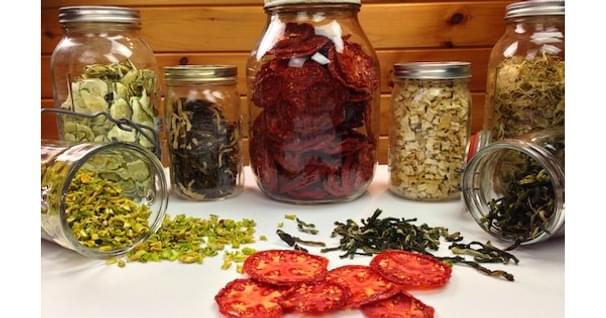
Dehydrating Food for Paddling Trips
For many years I've been an avid sea kayaker who resisted the temptation to dehydrate my food before any…
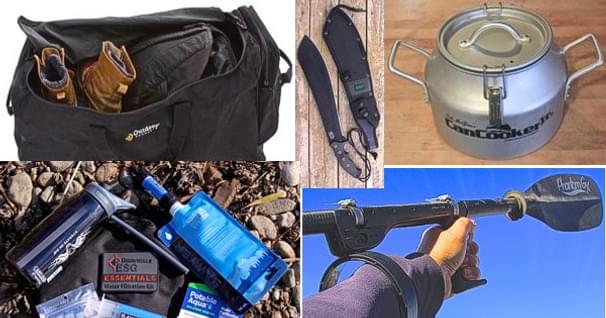
Crossover Gear for Paddling
Each year the outdoor industry pulls back the curtain to showcase more and more "stuff" for us to drool…
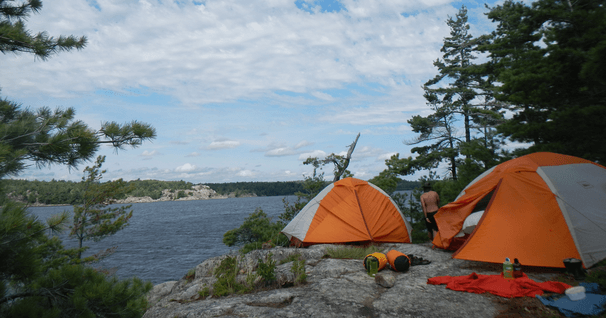
Kayak Camping Tips
Kayak camping is not all that different than backpacking - if anything it is easier as you don't have to…
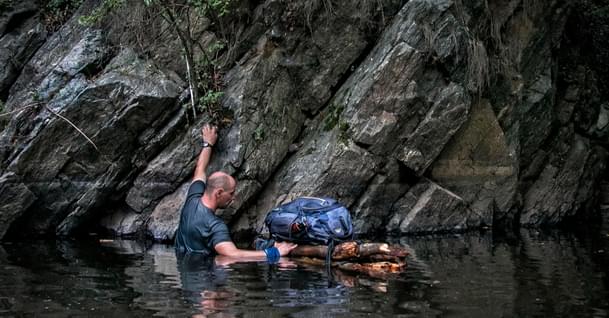
Survival Sense for Paddlers
One day, it's bound to happen: your attempted beach landing in the surf fails and your boat is swept…

IMAGES
VIDEO
COMMENTS
Ingredients: rice, coconut milk, jar of red curry paste, cayenne pepper, onion, peppers, mushrooms, zucchini, chickpeas. Instructions: Boil water in a pot. Pour in rice and stir. Go with a water-to-rice ratio of 2:1. In a frying pan, rehydrate veggies and chickpeas if necessary. Pour in a can of coconut milk.
Suggestions for Non-Perishable Canoe Food. Here are some of the best canoe trip meals and snacks that are quick to prepare and and lightweight to carry. Peanut butter and jam/jelly wraps. Instant oatmeal packets - good canoe trip breakfast option. Packaged pasta kits (e.g. just add water mac & cheese) Instant noodles.
If you plan to eat lunch on the water, cold soak recipes are great. We recommend our Sun-Dried Tomato Couscous. Regardless of the length of your trip, make sure to pack plenty of snacks. Plan to eat every 30-90 minutes when you are actively exercising, depending on the intensity of your activity.
Canoe Camping Meals: Guide to Easy and Nutritious Options for Paddlers. By ...
A 70-quart cooler fits nicely in the center of an Old Town 169 Discovery Canoe which is 35" wide at the beam. Canoe camping makes it easy to plan a menu that includes fresh fruits, vegetables, meats & dairy. When planning for an extended trip (five days or longer), plan your menu for your fresh meats, fish, salad ingredients to be consumed ...
Meal Plan for Canoe Camping Day 3. Canoe camping tip: dehydrated meals are supposed to be for 2 people, but if you are working hard, go with one per person. Breakfast: Instant oatmeal w/ dried fruit (raisins, blueberries, banana chips, etc.) Lunch: Salami and cheese tortilla wraps (meat and cheese also wrapped in vinegar-soaked cheesecloth ...
Make a column for each day of your trip and allocate room for three meals, one dessert and two official snacks on each day, along with an indication of daily water supply required (and where it will come from). Make space for other beverage allocations (juice, coffee, tea and alcohol if you fancy) too. Make a note under each daily column of the ...
The famous Swedish Hardtack is one of the many granola-Esque lunch meals that are easily stored on camping trips and nutrient-packed enough to allow you to make it until dinner without feeling hunger. To make Swedish Hardtack, you'll need: 1 teaspoon salt. 5 cups of rye flour. Half a cup of cooking oil.
Level up your ride bivouac meals with save easy but delicious kajak trip recipes, like curry, bitter buns, muffin, chilli and more! Even up your canoe car meals with these easy but delicious canoe trip recipes, favorite comb, cinnamon buns, cake, chilli and additional! ... Try Out The New Interactive KAYAK ROUTE PLANNER; Newsletter . Stay in ...
In this post I'll share an example canoe trip meal plan as well as a few tips on the process of planning and preparing food for a multi day trip. So let's get to the point. Tips 1. No perishables after day 2. The easiest way to stink up your food barrel or pack is a few day old meat or cheese that you had made plans for a few days in. If ...
There are three basic options when it comes to meals for your wilderness canoe trip: "real" food (non-dehydrated), pre-packaged dehydrated meals marketed to backpackers, and DIY dehydrated meals. ... Your easiest meal planning option for both packing and preparing is to buy pre-packaged dehydrated meals. There are many brands out there that ...
Kitchen gear to pack for your canoe trip Food & drinks. There's nothing like a good meal after a long day on the water. Depending on the length of your trip and how much you can bring, pack accordingly. Calories, protein, goodies, oh my. Meals: Create a meal plan for your canoe trip. Search for recipes or buy pre-packaged dehydrated meals.
Part of the beauty of a canoe trip is the simplicity. You'll be carrying everything you need with you - a sometimes mind-boggling, yet liberating, reality in contrast to the amenity-burdened lives we lead. Planning ahead to bring the right gear and be familiar with your route is important. Naturally, the necessity of being able to fit ...
He starts by packing a few staples: salt, butter, a little cooking oil, dried fruit and mushrooms, wild rice, a couple spice mixes. And though he brings an emergency supply of dried food, he ...
Printable Camping Meal Planner Template. We've created a printable camping meal planner that you can use to help you plan your meals. This includes a list of breakfast, lunch, dinner and snack ideas, as well as a packing list for all the food and equipment you'll need. Grab our free camping meal planner here:
Planning, preparing, cooking, and eating your favourite dishes just taste better on a canoe trip. Canoe Trip Cooking 101 is based on our years of experience tripping and camping around North America. Bill and I have been tripping for decades and over that time we've prepped, cooked, and ate a ton of meals.
How to Plan a (Successful) Canoe Trip. "The way of a canoe is the way of the wilderness, and of a freedom almost forgotten. It is an antidote to insecurity, the open door to waterways of ages past, and a way of life with profound and abiding satisfactions. When a man is part of his canoe, he is part of all that canoes have ever known.".
Wrap in foil before the trip. You need a nice bed of coals and a little time for these), Beans, Rice (great with almost anything, easy to make, filling, cheap) Fruit: Fresh apples, Fresh Oranges, Mixed stewed fruit, Mixed dried fruit. Bread: Garlic bread, Pancakes, Tortillas, Fruitcake, Banana bread, Bannock.
Make a meal plan for your camping trip to consider all meals, including snacks, to ensure you do not forget any food. As for clothing on a 3-day canoeing trip, you should wear one set of camping clothes and pack another set. Make sure you bring enough socks and underwear for each day.
Canoe Trip Menu Planner: Gunflint Trail, Grand Marais, MN Phone: 218-388-4487 Home; Adventure Trips. ... For Partial Outfitting Meal Plan--select from the following menu your food for your entire trip. Meal Plan includes food and food pack/food cooler. Price of Meal Plan with a food pack is $35/day.
Plan Your Own BWCA Canoe Trip Menu. You can select each meal for every day of your trip. All of our food is camp tested, high quality, and delicious. You can use this planner regardless of whether you are going on a solo trip or group trip into the Boundary Waters Canoe Area Wilderness or Quetico Park.
e) Make sure to plan extra meals and snacks as an emergency food supply. They should be quick to prepare, easy to eat and filling. The number of extra meals depends on the kind of trip you plan. But 30 % more provisions is the usual guideline for a trip in the wilderness.